2025-12-20 00:39:54
Every year, we make predictions. Our missives on 2025, made in October ’24, registered the most direct hits since we first pulled out our Ouija board a decade ago. Our objective isn’t to be right — though that helps — but to inspire a conversation that crafts better solutions. OK, enough of that. We begin with our 2025 report card, followed by our 2026 predictions.

The question isn’t when the AI bubble will burst, but what the catalyst will be. A: China. Trump has changed U.S. tariffs on China 17 times this year. They’re tired of having a major trading partner with sclerotic decision-making and the demeanor of a raccoon on meth. Since 2019, China has decreased its share of exports to the U.S. from 17% to 10%. Meanwhile, China’s global exports are up 40%, while imports are flat. Trump’s tariff policy is the definition of stupid: hurt others while hurting yourself. It has not inspired an increase in domestic manufacturing, but a decrease in exports, as reciprocal tariffs take effect, and a rerouting of the global supply chain around the U.S. “Higher prices, lower growth” makes for a lousy bumper sticker.
If I were advising Xi, I’d counsel him to go for the jugular by engaging in AI-dumping, a repeat of their aughts steel-dumping playbook. It’s already underway — and working. Eighty percent of a16z startups use open-source Chinese models. Same story at Airbnb. China is registering similar or better performance as the American LLM leaders, but with a fraction of the capex. Flooding the market with competitive, less-expensive AI models will put pressure on the margins and pricing power of the Mag 7, taking down a frighteningly concentrated S&P and likely sending the U.S., possibly the globe, into recession.

OpenAI is promising Oracle $300 billion — money it doesn’t have — for infrastructure Oracle hasn’t built. We can’t see the actual contract, but this is BS. The greatest AI hallucination yet is the assumption that in the next few years we’re going to build anywhere near the required grid and power capacity. OpenAI needs 20% of current U.S. electric capacity — equivalent to 250 nuclear power plants — at a cost of $10 trillion. There’s a five- to eight-year wait to connect a new data center to the grid. Meanwhile, China has more than twice America’s energy capacity at half the cost. Second greatest AI hallucination? Job creation. The average number of full-time employees at a data center is equivalent to the number of people working at two Applebee’s.

Based on its valuation, Nvidia is telling the market it will add an additional $800 billion in revenue over the next five years — equivalent to the combined revenue of Apple, IBM, Meta, and Tesla. OpenAI, which has $20 billion in annual revenue, is projecting it’ll add $180 billion in revenue over the same period — equivalent to the combined revenue of Disney, Fox, the New York Times, Paramount, and WBD. Also, OpenAI’s $1.4 trillion in spending commitments exceeds Argentina’s national debt.
Meanwhile, the competition is heating up. China is putting out comparable models at a fraction of the price (see above), Anthropic has captured the lead for enterprise users, and, as I predicted last year, the empire (Alphabet) is striking back. Gemini summaries are improving, and arguably the greatest concentration of AI talent resides at Alphabet. OpenAI could be our era’s Netscape, i.e., the disruptor that enjoys a moment in the spotlight before being eclipsed by an incumbent.

I’m bullish on Amazon, even though it underperformed the Mag 7 this year. The collision of AI and robotics is the Champagne and cocaine cocktail fueling Amazon’s retail margin expansion, catalyzing a 2x increase in the gross merchandise value of its largest business (retail) by 2033, without adding any human workers. Just as Ford’s assembly line slashed automotive production time by 88%, Amazon’s robotics investments have reduced the time from click to ship by 78%. The rest of the Mag 7 capitalizes on the elevation of information (bits) over objects (atoms), while Amazon is leveraging bits to move atoms faster and cheaper. Notably, the market hasn’t priced this in yet; in 2025 Amazon stock traded at a P/E ratio of 33, compared to its historic average of 58. The greatest accretion in shareholder value from AI will be at companies that leverage others’ AI. Specifically, Amazon. 
When technology gets cheaper, startups form, the ecosystem attracts cheaper and cheaper capital, which spurs innovation, and so on and so on. The cost of the personal computer decreased 58% during the 15-year dot-com boom, and U.S. IT spending increased 200%. The same pattern is happening now with AI: The cost of GPU operations has fallen by 74%, while global AI funding has risen by 280%. The key metric for space? Over the past 15 years, the cost to get a kilogram of payload into orbit is down 89%, while private U.S. space investment jumped 6x.
SpaceX is dominant, registering 84% of U.S. space launches in 2024, up from 18% in 2008. If I were running investor relations, I’d position SpaceX as follows: Google owns 93% of information with search, Meta controls two-thirds of social connection, Amazon has half of e-commerce. SpaceX controls 90% of everything else in the universe. Everything is a subset of the addressable market that is space.

TikTok’s success underscores the biggest mistake marketers make, believing choice is a good thing. It isn’t. Consumers spend five days per year deciding what to watch on Netflix. TikTok has only one channel, and it’s the best one you’re ever going to watch. Forty-three percent of Americans 18 to 29 get their news from TikTok. We also spend more time, on average, with TikTok (54 minutes per day) than with friends (35 minutes). When I say TikTok is our new best friend, I mean CCP spy. But I digress.
The math on TikTok’s forced sale doesn’t math, though, unless you’re one of the president’s cronies. TikTok’s U.S. ad revenue was $12 billion in 2024. Applying a 10x P/S ratio, its U.S. business has an implied value of $120 billion. Accounting for a revenue share with China, Trump’s deal values U.S. TikTok at $28 billion. But I’m a Democrat, so I’m not allowed to invest. These insider deals reduce people’s faith in the market, raising the cost of capital for everyone. U.S. economic policy could best be described as corrupt, but stupid.
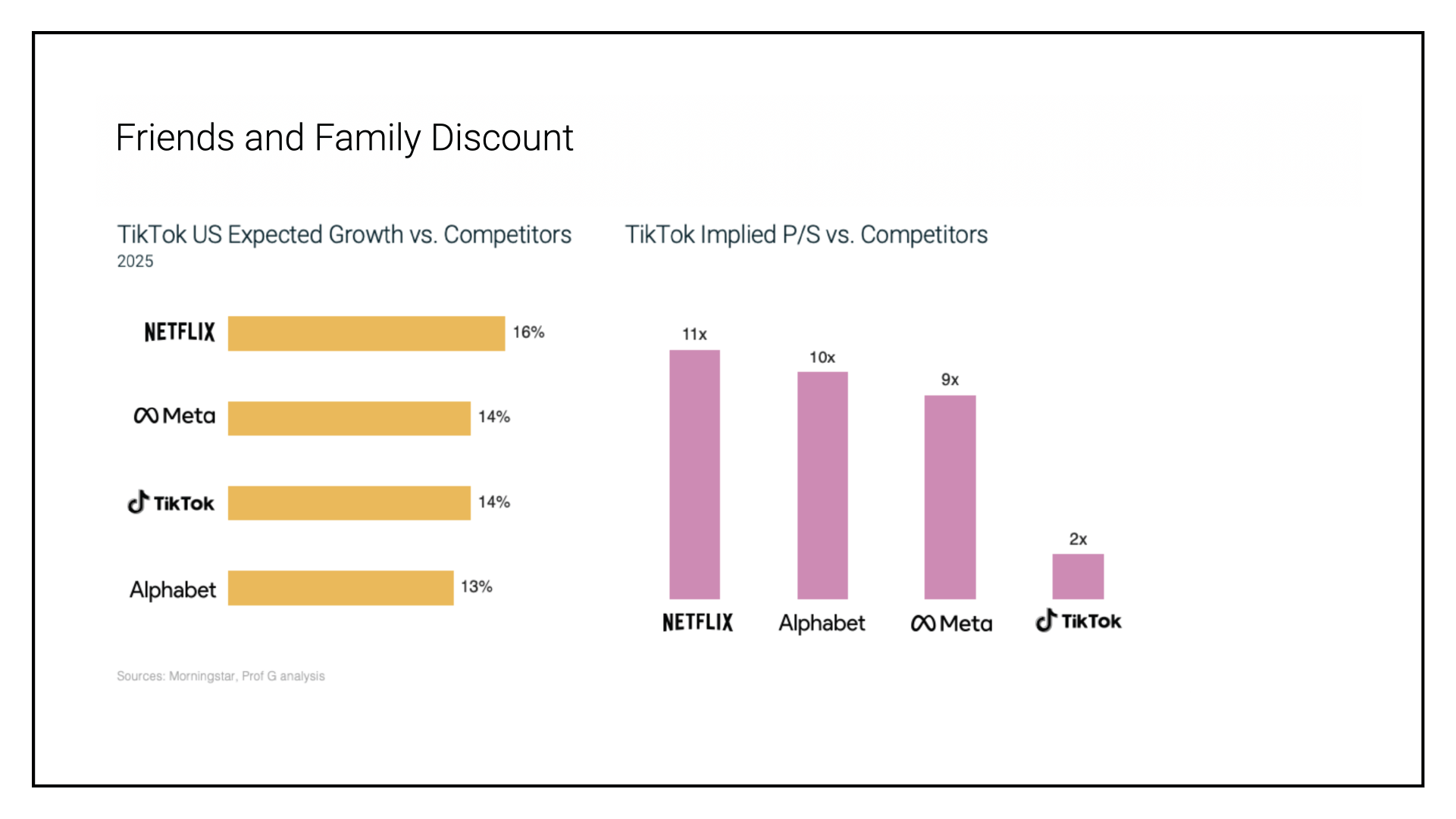
Hollywood is the new Detroit, but with better weather. For creatives, the return on human capital is inversely correlated to the size of the screen. Seventy-eight percent of Americans age 10 to 24 watch TV and movies on YouTube and TikTok. The Kids Diana Show on YouTube averages between 2 and 10 minutes per episode — perfectly calibrated for young people’s shrinking attention spans. The show registers 137 million subscribers; Disney+ has 128 million subscribers.
The other meteor headed for Hollywood is AI. What AI will do to Hollywood is what podcasting is doing to TV. The Late Show with Stephen Colbert employs 200 people, costs $100 million, and makes $60 million. When Colbert shifts to podcasting, he’ll take eight people with him and make just $20 million, but it’ll only cost $5 million to produce. The means of production are being arbitraged. There will be outrage from the creative community, who believe they’re too precious to face disruption. But consumers, much less the Ellisons, don’t give a shit.

Automobile deaths kill 40,000 Americans annually — equivalent to prostate cancer, Parkinson’s disease, and breast cancer combined. Autonomous driving may be the equivalent of a cure for (some types of) cancer. A study evaluating tens of millions of miles driven by Waymo found that its autonomous cars were involved in 96% fewer vehicle-to-vehicle crashes, resulting in 90% fewer bodily-injury claims, and 92% fewer pedestrian injuries compared to cars driven by humans.
Waymo went from 38,000 paid rides per month in 2023 to 1 million just two years later. The company is lapping the competition, logging 100 million fully autonomous miles, compared to Tesla’s 1.25 million miles with human safety monitors. The second horse to watch is Uber. It’s technology-agnostic, choosing to pour capital into the consumer experience. As former CEO Travis Kalanick said, the most expensive part of the business is the person in the driver’s seat.
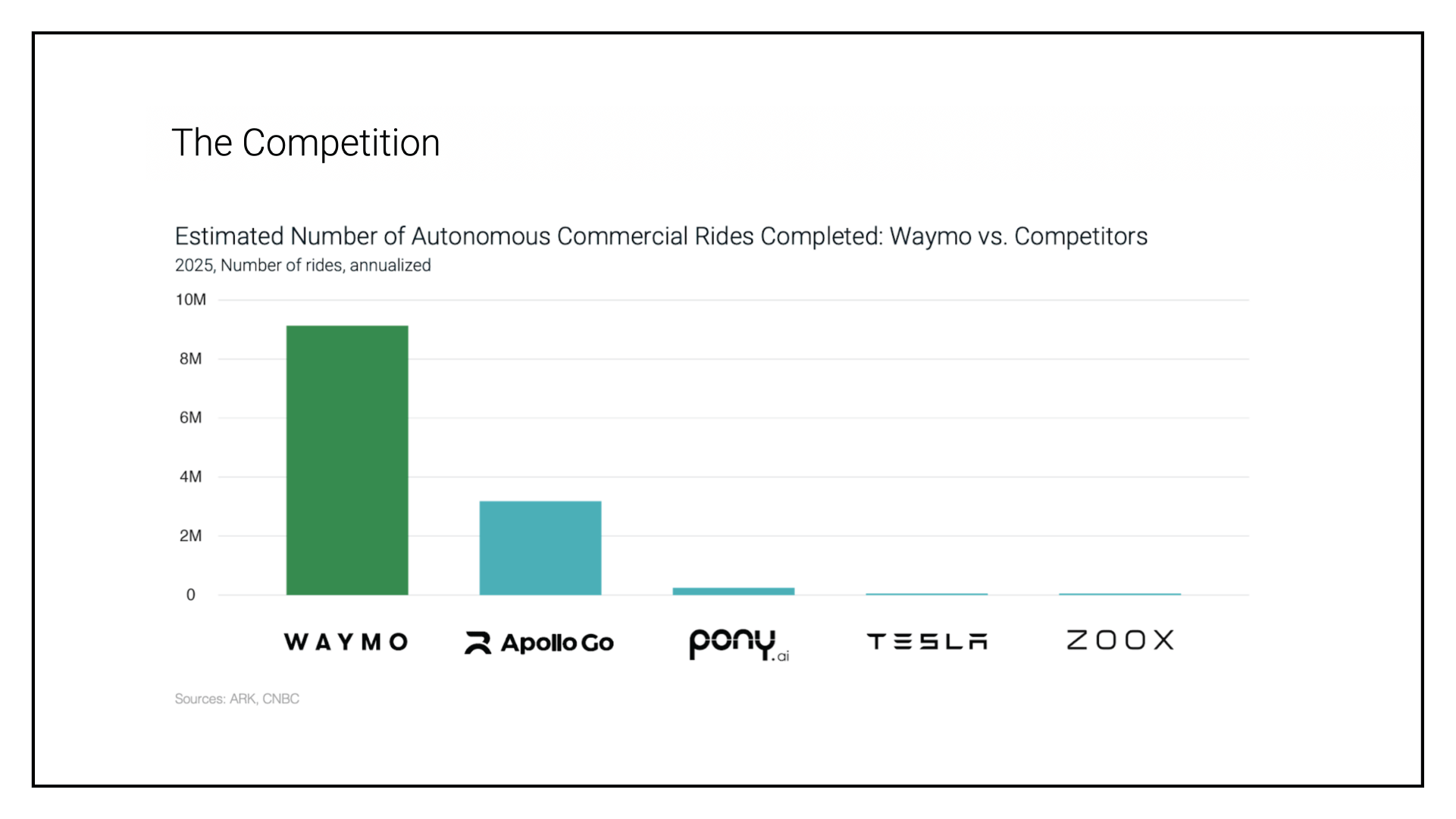
Similar to self-driving cars circa 2015, humanoid robots are another Musk weapon of mass distraction designed to draw attention away from the fact that Tesla is a car company. Tesla’s market cap per car sold is 77x what it is for GM and Ford, 28x Toyota, and 24x BYD. According to Musk, Tesla’s Optimus robot will be an “infinite money glitch” that ends poverty and performs surgery. It’s as if he’s on ketamine. According to MIT robotics professor emeritus Rodney Brooks, “We will have plenty of humanoid robots 15 years from now, but they will look like neither today’s humanoid robots nor humans.” The current / future opportunities aren’t robots that mimic humans, but robots that augment / replace humans at industrial scale.
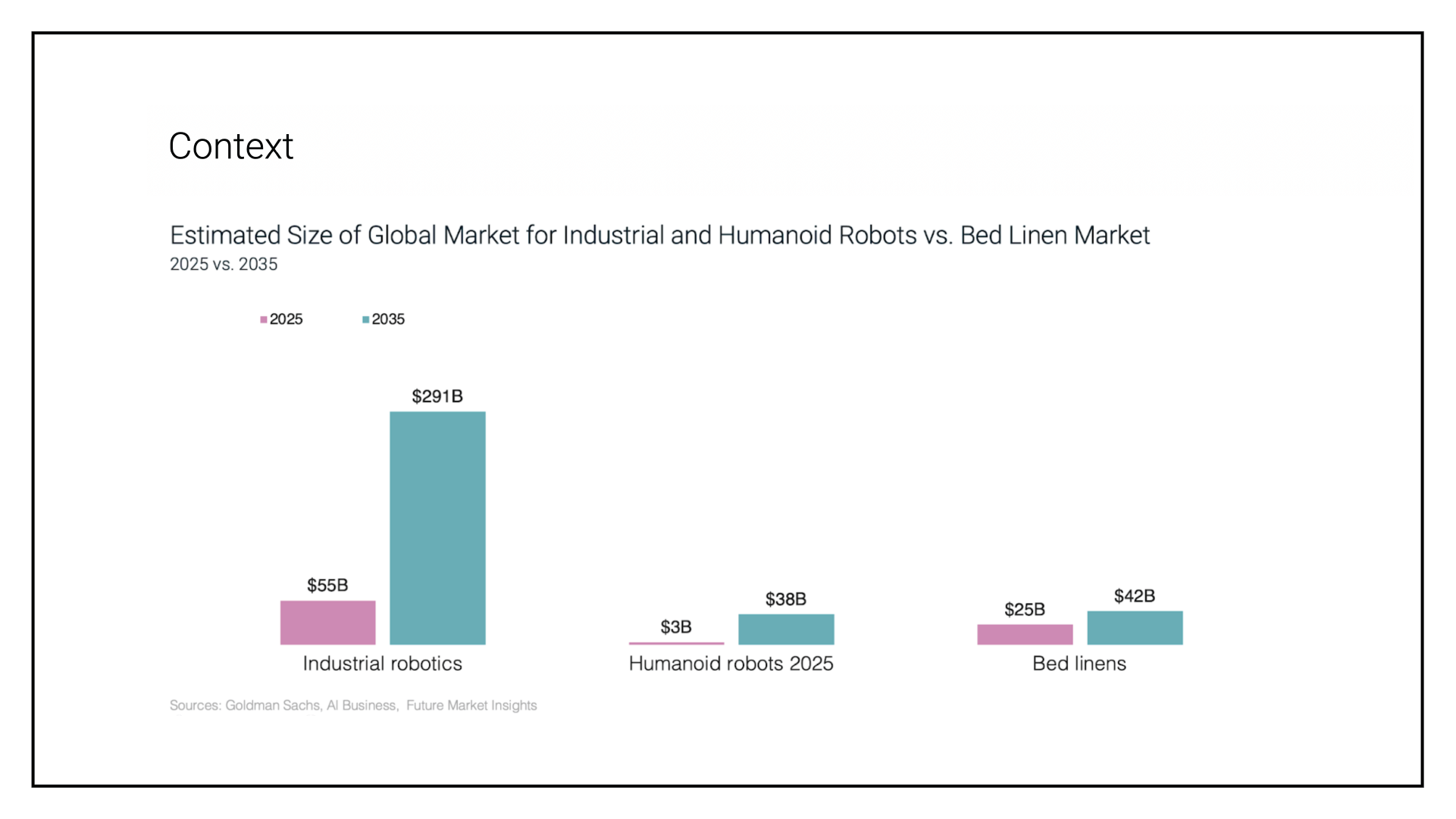
Prediction markets leverage the wisdom of crowds. In turn, crowds supercharged by integrations with news brands create a virtual self-propulsion marketing machine. Participants may be deluded into believing they’re engaging in an intellectual pursuit when they bet on an election’s outcome, but it’s gambling, just more fun and interesting. What GLP-1s did to fast food, prediction markets are doing to the gaming business. Aristocrat Leisure, Caesars Entertainment, DraftKings, Evolution Gaming, Flutter Entertainment, and MGM Resorts are down 22% YTD, on average. Las Vegas tourism is down 8%. Nobody will be in Vegas once Vegas is on everyone’s phone.
The externalities are huge. Half the men in the U.S. between 18 and 49 have a sports betting account. Among sports bettors, 23% say they’re addicted; the share jumps to 37% for Gen-Z. One in five people with a gambling addiction attempt suicide. Personal bankruptcy filings increased by 28% in states that legalized sports betting after a 2018 Supreme Court ruling. There are also civic externalities, as prediction markets represent the mother of all insider trading opportunities. Wagering on what Musk will Tweet next, Trump’s Fed pick, the speed of a pitch, or when a candidate will drop out of a race invites corruption into every aspect of American life.

There’s a use case for AI companions, but it’s uncomfortable — a sad story about lonely old people. One-quarter of Americans 65 and up are socially isolated, increasing their risk of stroke and dementia by 30% and 50%, respectively. The share of the population aged 65 and older is projected to reach 21% by the end of the decade. In one year-long analysis of older Americans living alone, 95% of participants said bots reduced loneliness. If synthetic relationships can make older people less lonely and stave off dementia, that’s great.
The problem? Young people aren’t developing the skills to navigate life’s hardest / most rewarding thing: relationships. Google search volume for “how to make friends” has increased 5x since 2004, while the share of Americans who say they have no close friends increased 4x from 1990 to 2021.
I believe synthetic companions are the next opioid crisis for young people. On Character.ai, 79% of the users are under 35; the average session is 93 minutes. In any given week on ChatGPT, 560,000 people show signs of mania or psychosis, while 1.2 million people engage in conversations that indicate they have a plan to self-harm. Unfortunately, Congress is The Walking Dead meets The Golden Girls. They see the danger from synthetic relationships about as clearly as the propaganda threat posed by TikTok.
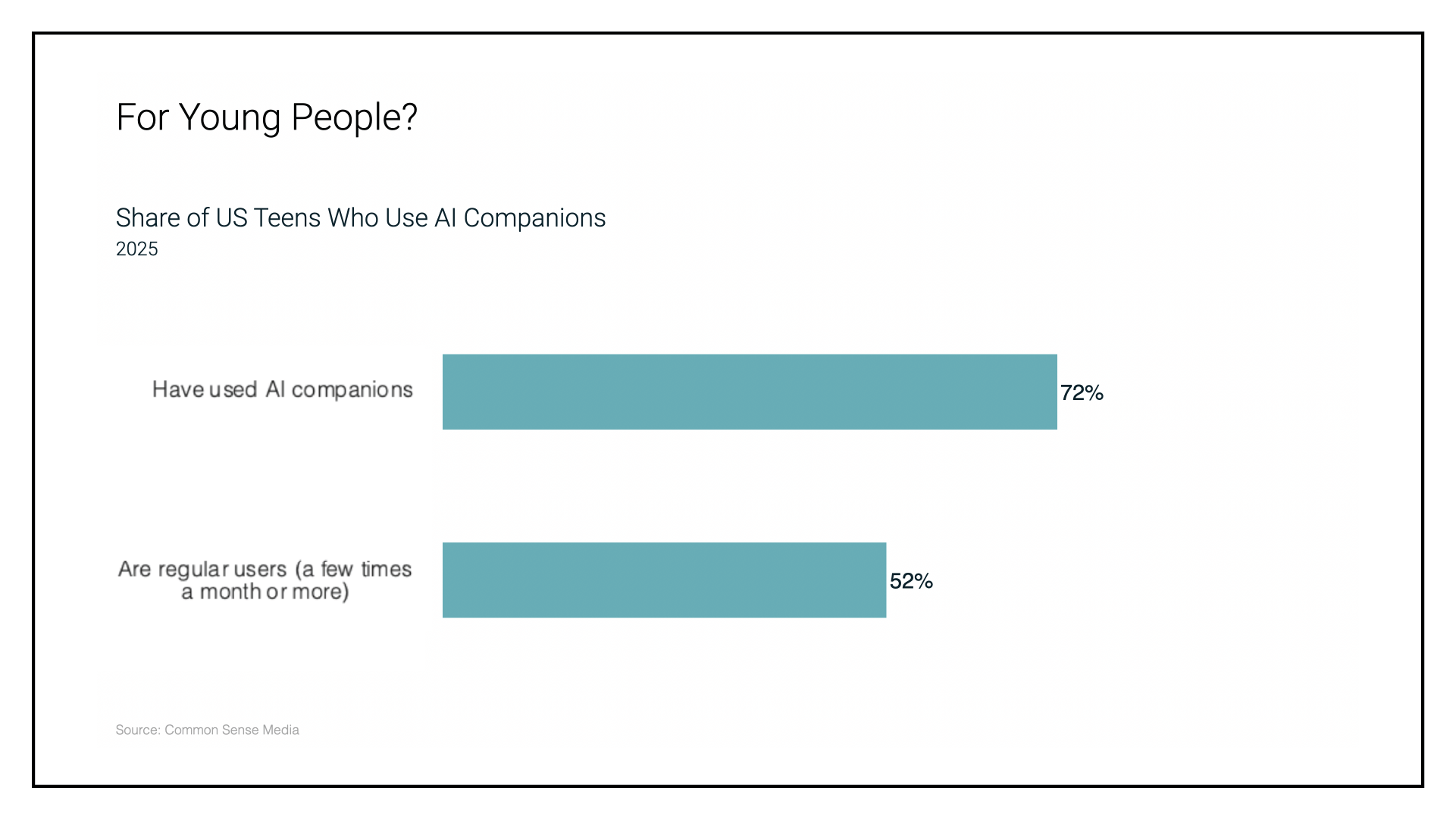
Some of the most successful people of our age are college dropouts — Mark Zuckerberg, Larry Ellison, Oprah. You should assume your son is not Oprah. Despite the noise about employers removing degree requirements, the share of workers without a degree increased only 3.5% between 2019 and 2024, while 45% of all firms made no changes to their hiring practices. In pure economic terms, the median household income for a college graduate is more than 2x what is for someone without a degree. College graduates see better nonfinancial outcomes, too, in the form of lower rates of obesity, divorce, and suicide. On average, they also live six years longer.
After declining during the pandemic, enrollment has rebounded. The issue isn’t value add, but value (i.e., cost). Adjusted for inflation, tuition rose 53% and 32% at public and private schools, respectively, between 2000 and 2025. Why? A: My industry is corrupt. We artificially sequester supply so we can raise tuition faster than inflation. Faculty, administrators, and alumni are drunk on exclusivity. We’ve lost the script and begun believing we’re luxury goods, not educators.
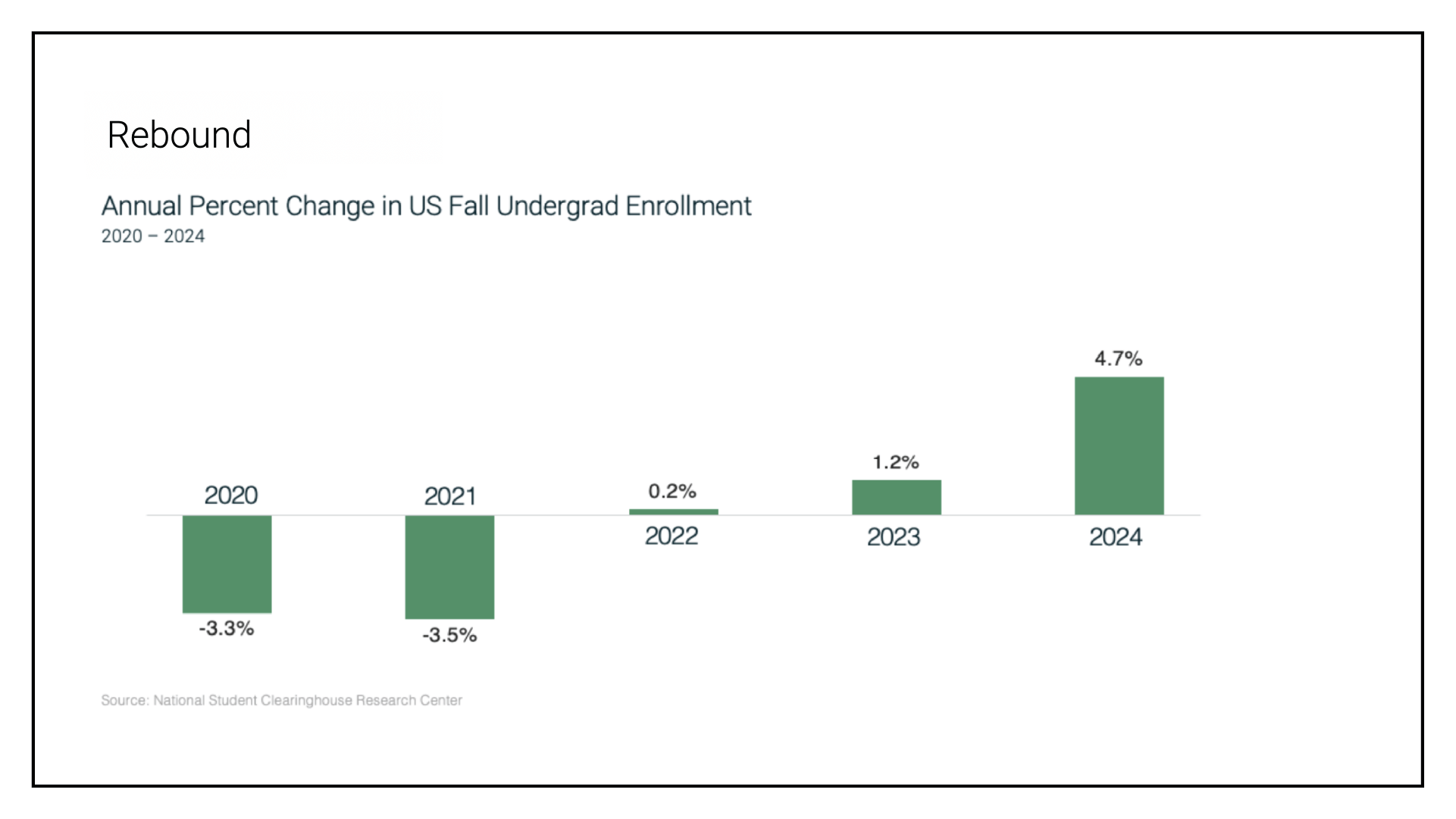
Finally, Team Scotland will reach the semifinals of the World Cup on the back of a Pele-like performance from Scott McTominay. Hey … I can dream.
The best way to predict the future is to make it. I hope the New Year brings you the perspective and presence of mind to realize that, if you live in America, are healthy, and have people who let you love them completely, 2026 will be the best year of your life.
Life is so rich,

P.S. Start the year off with a New York Times bestseller. (Flex.) Notes on Being a Man is available in all the usual places.
The post 2026 Predictions appeared first on No Mercy / No Malice.
2025-12-13 00:38:56
Netflix’s $83 billion deal to buy most of Warner Bros. would unite Stranger Things and KPop Demon Hunters with Game of Thrones and The White Lotus, creating a streaming powerhouse. With Netflix’s Ted Sarandos and Greg Peters at the helm, the combined company would also be led by the smartest team in the entertainment industry. I know Ted and, like most who meet him, admire him.
I don’t know David Ellison, and I find kids of billionaires trying to reshape the culture with a 12-figure jackhammer a bit … gross. But the Paramount boss — who’s trying to thwart Netflix with a hostile $108 billion bid for Warner Bros. — is right: A Netflix takeover would likely be bad news for consumers at a time when many are facing an affordability crunch. The fight over the century-old studio is also a great example of the cronyism and head-up-your-ass economics of the Trump administration that adds fuel to the crisis.
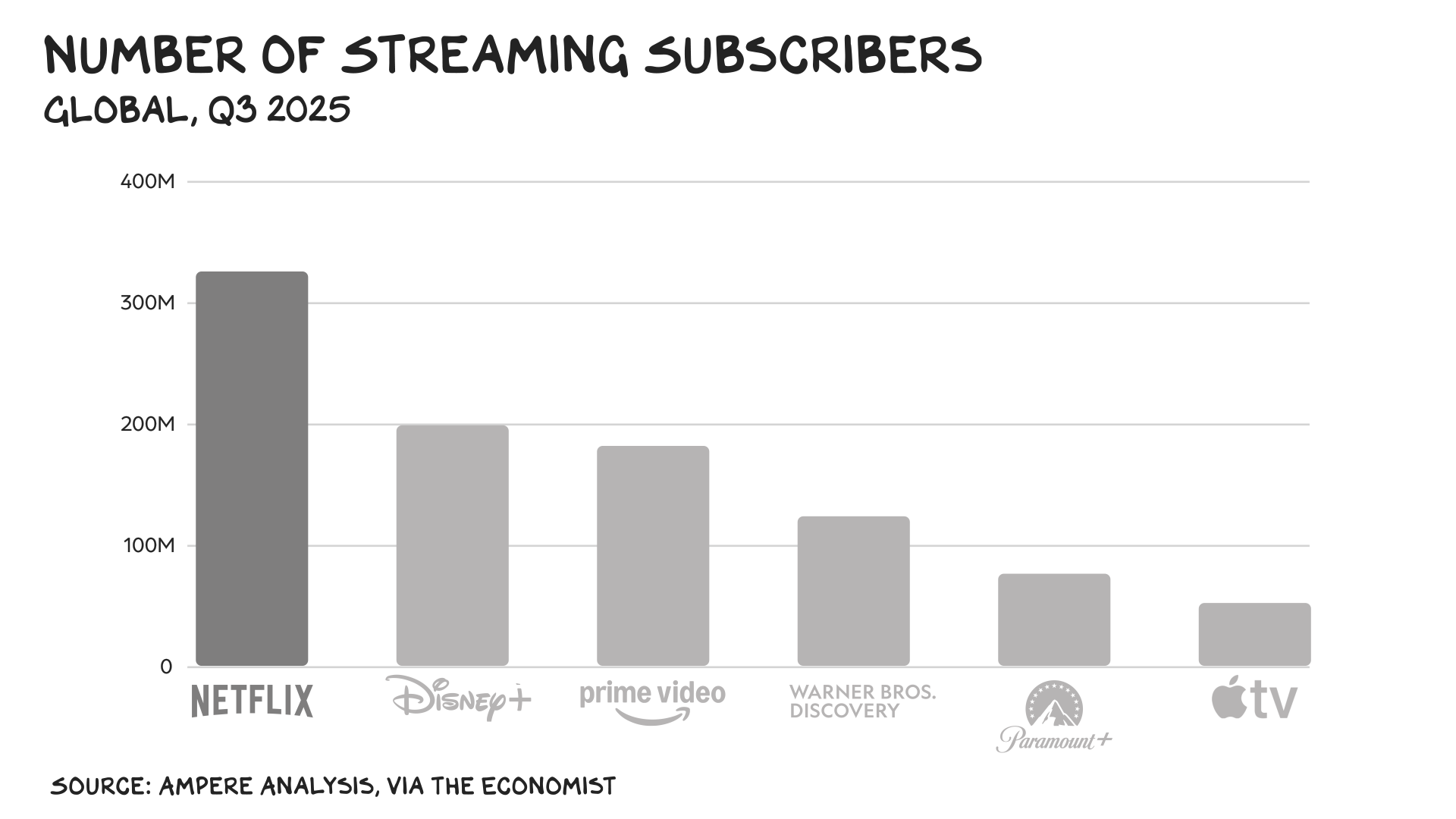
Anticompetitive
Ellison argued on CNBC that allowing two of the biggest streaming services to join forces is “anticompetitive.” As the son of Larry Ellison, the world’s third-richest person, Paramount’s CEO has close ties to Donald Trump and access to a seemingly bottomless pool of capital. It’s obnoxious listening to a guy raised in a gravity-free financial environment warning others about the dangers of market distortion. After giving that interview, did he go into the kitchen of the restaurant and lecture the line cooks on the dignity of minimum wage? I digress.
Socialism
After giving the elder Ellison a significant role in his plan to transfer TikTok’s U.S. operations to a group of American investors, Trump is pledging to get involved in the regulatory fate of a Warner Bros. takeover. This is straight-up socialism — the state controlling the means of production.
Everyone knows we’re sliding into a stew of autocracy/kleptocracy, so Sarandos also wooed Trump in the lead-up to announcing his agreement on Dec. 5, securing a secret White House meeting with the president. But before unveiling his rival offer two days later, Ellison reminded his adversary who has the political edge. The Silicon Valley scion was spotted beside Trump at a ceremony in D.C. Who the president, or podcasters, believe is the rightful owner shouldn’t matter. It’s simple: It should be whoever shows up with the biggest check and passes regulatory reviews.
Dominant Position
Concentration of power in streaming might corrupt the market, similar to the corruption the country endures when a few people can reshape media, tech and Washington. Anyway, back to streaming. With more than 300 million subscribers, Netflix already has a leading position. Netflix, Amazon Prime, and Disney control over 60% of the market. Acquiring Warner Bros. would give it even more power, with one of the largest libraries of premium scripted content and some of the most valuable entertainment franchises. Combining HBO — the gold standard of television — with Netflix — the streaming superstore — is like fusing LVMH and Walmart.
Less Choice, Higher Price
If Netflix captures HBO Max, the streaming war (ad-free, original content) is over. The upshot, despite Netflix’s assurances that the combo will create greater value for consumers, is fewer choices. At some point, as concentration intensifies, all the companies’ stocks will fall, as there are fewer people who can afford to buy their stuff.
This trend is well underway, with the top 10% already accounting for 50% of consumer spending, making the economy more fragile. One-tenth of the population can crash the train. A Paramount deal also raises competition concerns, given the two companies have rival film studios with theatrical releases and overlapping streaming services. But there’s a reason Paramount would probably face an easier regulatory path — and it’s not just the support it would receive from Trump. It boils down to market share.
Streaming prices are climbing, along with the cost of groceries, gas, and housing, as the industry consolidates. The average subscription price for the top 10 U.S. platforms has risen 12% this year, far outpacing inflation, following double-digit increases since 2022. U.S. households spend an average of $70 a month on streaming services, a significant sum for people whose grocery bills have climbed 30% over the past five years.
Chicken vs. Beef
The companies say they have to raise prices to pay for the premium content they provide. But what the increases really signal is a transfer of capital from consumers and labor to shareholders. Adding the studio and streaming assets of Warner Bros. would give Netflix even more leverage.
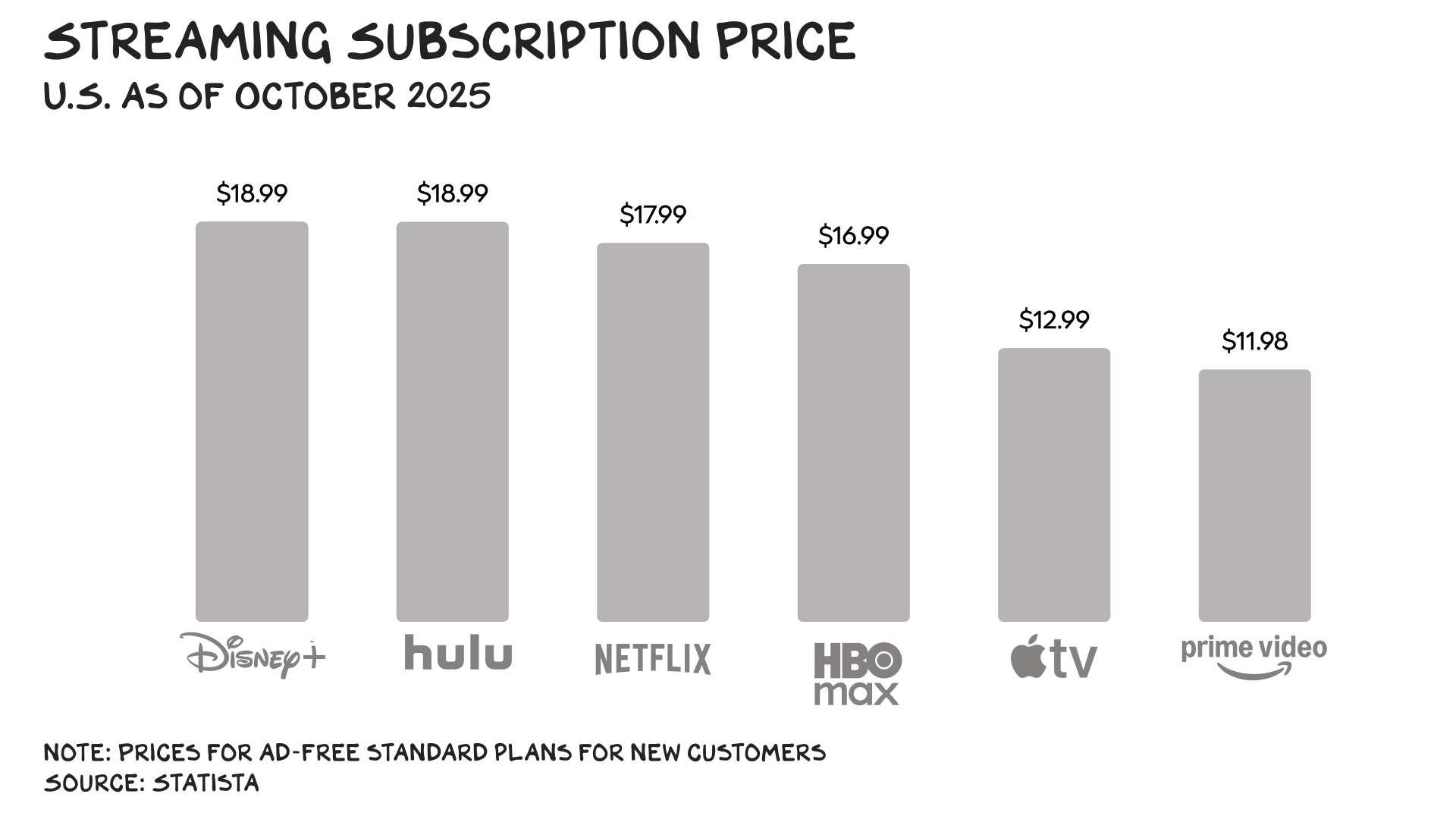
If Netflix wins, the most critical question will be whether it’s competing with premium streaming platforms or virtually all digital video content vying for attention. Netflix isn’t nearly as dominant if you factor in Alphabet’s YouTube and ByteDance’s TikTok, as Kara Swisher, my Pivot co-host, points out. But regulators should adopt the narrower market definition. Otherwise it’s akin to chicken producers defending their control of the market by suggesting their competition extends to cattle ranchers and pistachio farmers.
Also, consolidation won’t stop with Netflix or Paramount and Warner Bros. The deal will only put more pressure on rivals, including Comcast, to follow with their own transactions to scale their streaming platforms.
From Indignation to Ideas
Streaming subscriptions are just one part of a wider debate. Everyone from Donald Trump to New York Mayor-elect Zohran Mamdani is talking about affordability. However, the country is long on indignation and short on ideas or programs to actually bring prices down. The president has insisted that tariffs will boost the economy, when in fact they’re pushing prices higher and fueling concerns over the cost of living. Trump, who once vowed to “make America affordable again,” now calls concerns about increasing prices a “hoax” perpetrated by the Democrats.
Americans know this is bullshit. The use of buy-now, pay-later services is rising to record levels this holiday season. Yet they’re also not buying the message from Democrats, who highlight the need to curb health, housing, food, and energy costs but resort to stoking outrage and throwing money at people vs. implementing concrete structural change. Here are four ideas that aren’t sexy (i.e., they will take work):
Build, Baby, Build
Housing should be at the top of the agenda, as it’s the primary culprit driving the lack of affordability. Half of renter households in the U.S. are cost-burdened, meaning they spend 30% or more of their income on shelter. Higher expenses curb labor mobility and productivity, deter families from seeking medical care, contribute to anxiety and depression, and fuel homelessness. While rent control is tempting, it suppresses development longer term, only adding to the problem. Higher costs for labor, building materials, and regulatory compliance exacerbate the housing shortfall.
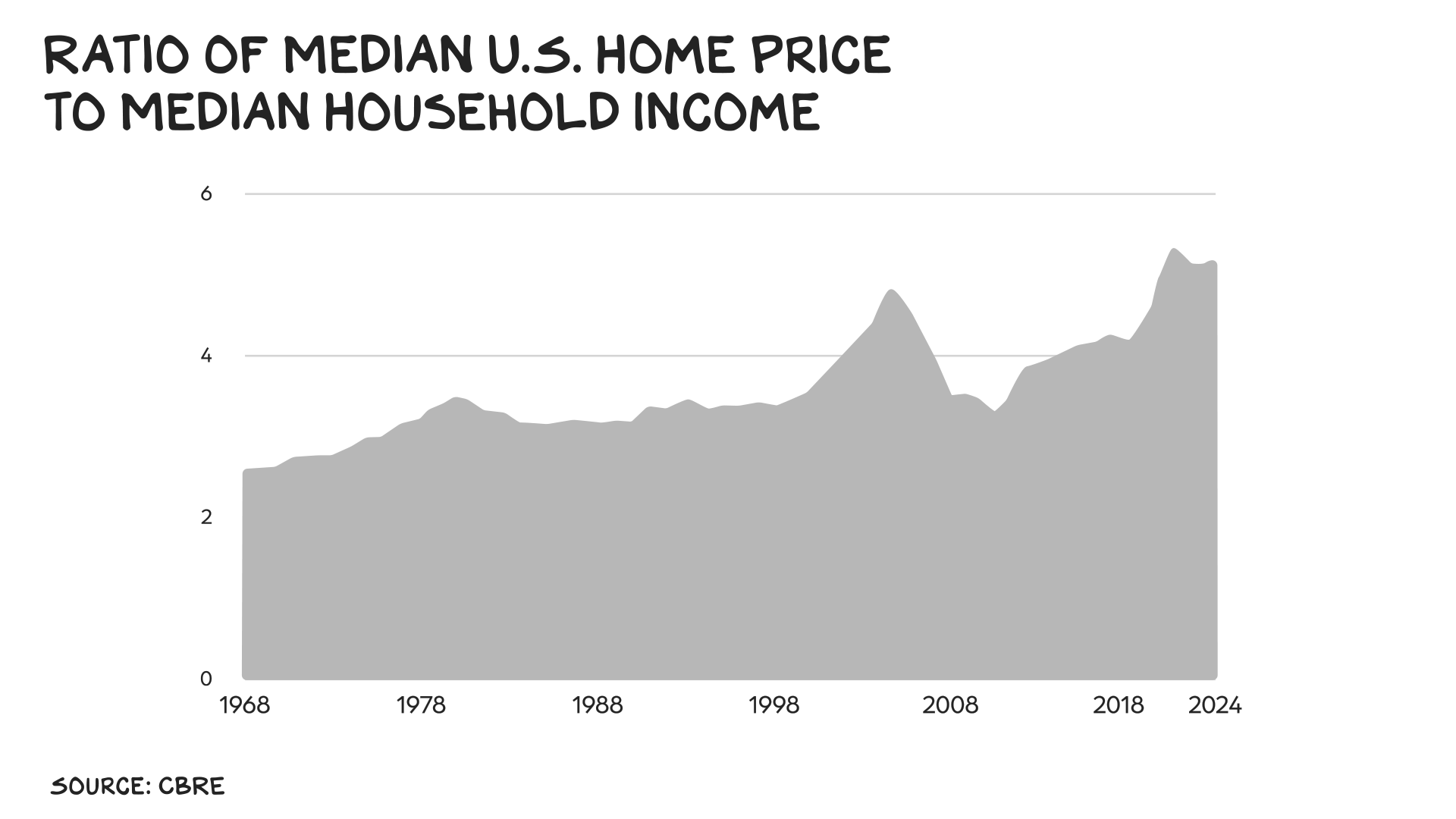
We should have tax credits to unleash private development to build 8 million to 10 million homes in the next decade. Yimby laws (yes in my backyard) and cost-effective building are also part of the solution. Manufactured homes, built in factories and finished on site, are 35% to 73% cheaper than homes built entirely on location.
Nationalize Medicine
The U.S. healthcare system is broken — for the bottom 90%. Many Americans are one medical expense away from sliding into debt. More than 30 million citizens, especially Black and Hispanic adults, borrowed money to pay for healthcare last year, accumulating $74 billion in medical debt. Enough.
Let’s take Medicare and lower eligibility by two years every year for the next decade. That would bring the age of eligibility to 45 in 10 years. What is that called? Nationalized medicine. We can help younger people in other ways. They aren’t the ones accounting for the vast majority of surging health costs.
Impose Tuition Caps
We also need tuition caps based on income. As a freshman at UCLA, I benefited from an annual tuition of just $1,350 (and an admissions rate of 74%). A degree from a prestigious school opens doors and potentially quadruples the income a person can expect to make, but the ROI has declined as costs have ballooned.
If your family is middle-class, the tuition should reflect that. Colby last year announced a program to cap the cost of tuition, room, and board at $10,000 a year for families who earn up to $100,000, and $15,000 for those with incomes ranging from $100,000 to $150,000. That compares with a net price of as much as $53,000 a year.
If universities with endowments greater than $1 billion aren’t increasing freshman enrollment faster than the population is growing, they should lose their tax-free status. They’ve decided they’re Birkin bags, not public servants.
Trust-Busting
Concentration of power harms consumers and workers, with the benefits flowing to shareholders. It’s up to regulators to break up or block harmful oligopolies that stifle competition. The nation’s regulators are supposed to enforce antitrust law based on guidelines about market share and other standards, but giving the president the ability to “engage in post hoc manipulation” undermines the rule of law, as Herbert Hovenkamp, an antitrust scholar, told the New York Times.
More Oxygen
The pursuit of Warner Bros. is more than just a transaction. It’s a microcosm of a wider emergency. We can’t complain about surging costs while ignoring the factors behind them. We need to have an adult conversation, saying no to harmful deals and yes to policies that spur competition and rein in health, housing, and education costs.
It’s telling that the loudest objection to this nascent monopoly comes from a Hollywood mogul who’s never lived outside one. But we should listen to him. Consolidation is a tax on the young and the poor, levied to protect the old and the rich. Affordability begins with a simple idea: more firms, more competition, more oxygen.
Life is so rich,

P.S. This week I spoke with Tristan Harris, former Google design ethicist and co-founder of the Center for Humane Technology, about the AI dilemma. Listen here on Apple or Spotify, or watch on YouTube.
The post The Streaming Wars and Affordability appeared first on No Mercy / No Malice.
2025-12-06 00:14:36
“Don’t read the comments,” I tell people, just before I have a drink and … read the comments. I knew my book Notes on Being a Man would spark controversy, as you get the most flak when you’re over the target, and some of the criticism (likely) misses the mark. The comment that hits home: I reverse-engineer what’s worked for me (economic security, relationships) to masculinity and don’t acknowledge other paths to fulfillment. Fair. Many others offered constructive criticism, and some of the criticism has merit. What surprised me was how many of the commenters were therapists parroting talking points along the lines of “Before anything, men must work on themselves (i.e., get therapy).” This is nonsense.
I want to be clear: Therapy is a good thing, especially for the 23% of American adults who experience mental illness. But mental health influencers position therapy as a prerequisite for a better life, rendering it a Birkin bag for your feelings (i.e., a luxury good), and position many of life’s obstacles as traumas to be addressed for $200/hour. This is a misdirect. I believe America’s mental health crisis is a multidimensional problem largely shaped by economic precarity. Five of the world’s 10 happiest countries are Nordic nations with strong social safety nets. Costa Rica and Mexico (ranked 6th and 10th) achieve comparable happiness scores thanks to their strong family and social ties. My solve? A: Detonate a mental health bomb in America, and invest in programs that increase material well-being — a $25/hour minimum wage, affordable housing, universal healthcare, and a stronger social safety net. The free gift with purchase? Reducing financial stress would mean Americans could worry less, socialize more, start families, and, if they struggle with mental health, pay for therapy.
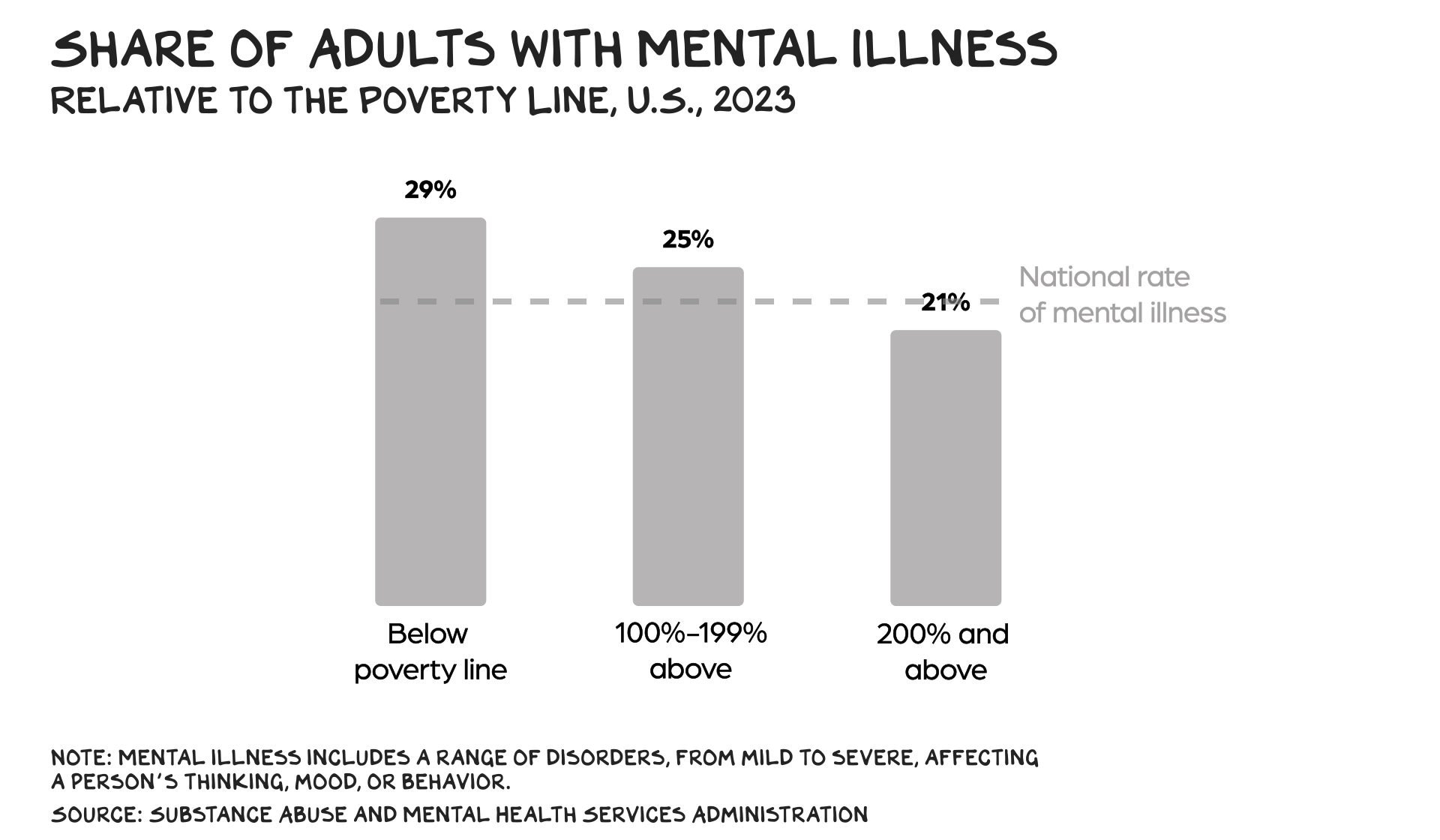
Doctors currently believe there are 227 symptom combinations that can lead to a diagnosis of depression, but there are no blood tests or imaging scans to aid that diagnosis. In an estimated 15% of cases, antidepressants provide benefits beyond the placebo. Talk therapy also helps, but the range of modalities make it difficult to quantify the impact of treatments. As neuroscientist Barbara K. Lipska wrote in 2018, “mental illness remains deeply enigmatic, its causes generally unknown, its cures undiscovered.” And yet, social media feeds are overrun with mental health influencers peddling therapy as the answer.
Writing in the New Yorker, Katy Waldman observed in 2021 that therapy-speak had left the couch and conquered social media. It’s only gotten worse: Scroll through your feed and you’ll see posts about self-care, coping mechanisms, codependent relationships, and avoidant attachment styles. Centering ourselves, setting boundaries, sitting with our discomfort, and being present don’t require explanation — these terms are as essential to internet culture as LOL. For many this vocabulary screams privilege. According to Waldman, the confessional/performative nature of social media results in “the language of suffering often find[ing] its way into the mouths of those who suffer least.”
Scaled beyond its intended domain, therapy-speak is corrosive. According to psychotherapist Jonathan Alpert, the rise of therapy culture has turned a tool for meaningful change into a “comfort industry” that’s making Americans sicker, weaker, and more divided. “We live in an era where disagreement is treated like trauma, and emotional reactions are weaponized for political gain,” Alpert writes. “On social media, vulnerability is currency. On TikTok, influencer ‘therapists’ dish out instant validation in 30-second bursts. The most anxious voices often hold the most influence. Complex issues get reduced into content. Millions watch, but few get better.” One 2022 study of mental health videos on TikTok found that 83% were misleading, 14% provided potentially damaging advice, and only 9% were produced by content creators with relevant professional qualifications. Similar to supplements, therapy is a good thing that’s easily exploited by hucksters. But if supplements are a pipeline to getting red-pilled, therapy culture is a sinkhole of misinformation, manufactured fragility, and needless suffering.
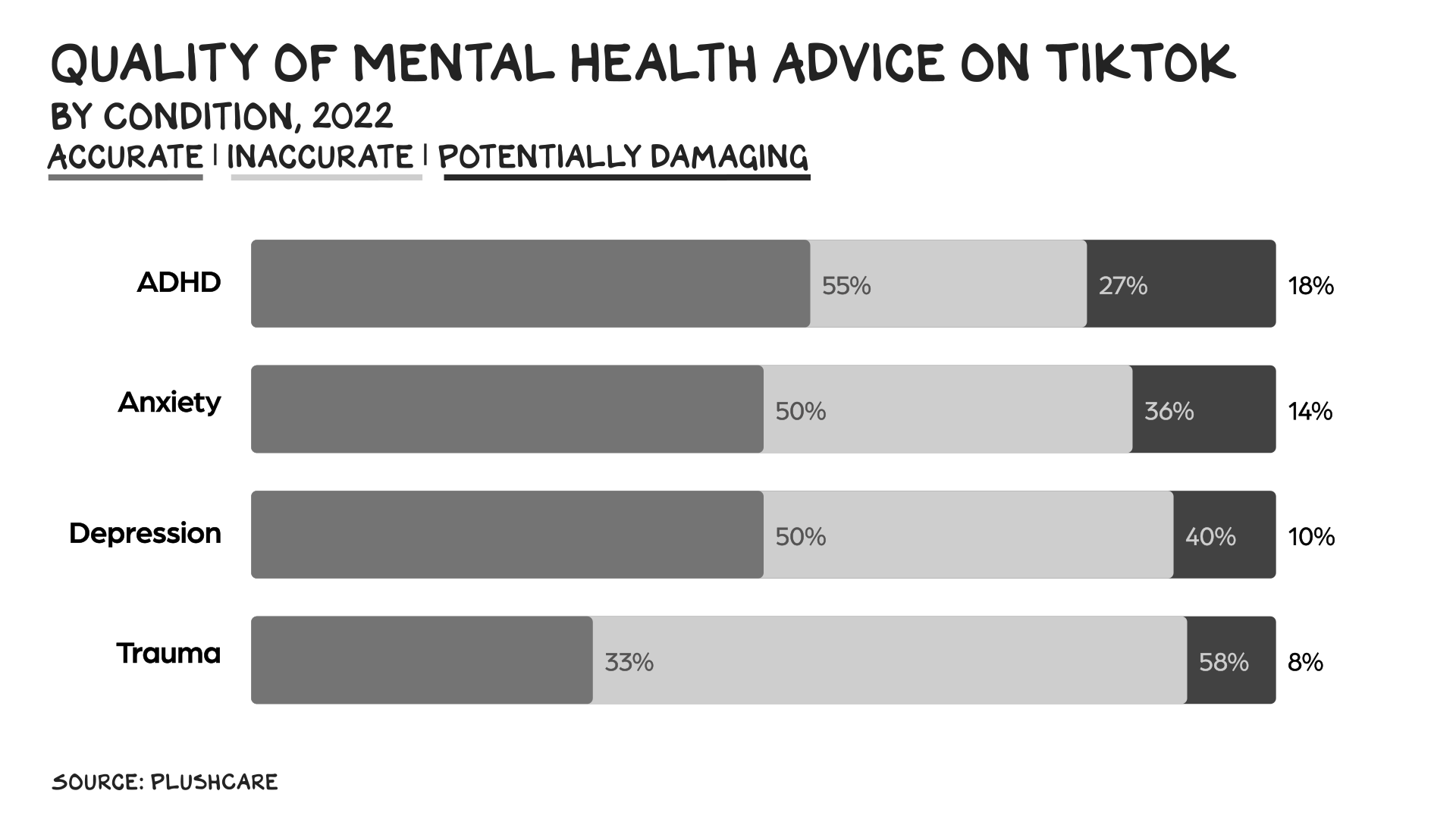
I’ve had limited experience with therapy. Before my divorce, my wife and I saw a couple’s counselor. I’ve also tried ketamine therapy. The session was illuminating, but I haven’t gone back. There was a time when a couple in a bad marriage would’ve talked to a priest. But the share of adults who say religion is an important part of their daily life has dropped from 66% in 2015 to 49% today, according to Gallup, closing off one avenue of talk therapy for many Americans. Sharing your troubles with your local bartender has also fallen out of fashion. Talking to your friends remains an option, though friendship rates are declining, with 12% of people today saying they have no close friends at all. Alcohol consumption is at a 90-year low, with Gen Z driving the abstinence trend, robbing young people of one vital form of social lubrication.
I’ve been criticized for saying alcohol can be additive for many young people, but the risk to a 25-year-old liver is dwarfed by the risk of social isolation. If I told young people to attend church, I’d likely get pushback from some quarters. Meanwhile, counseling young people to invest in their fitness and take social risks so they can make friends and form romantic partnerships are nonstarters for therapy culture … unless and until you’ve had therapy. We’re social animals. As social connections atrophy and fray, we’re becoming more anxious and depressed. Therapy is an expensive Band-Aid for a larger problem. But even taken on its own merits, only 9% of Americans give the U.S. healthcare system a grade of A or B for addressing mental illness, according to Gallup.
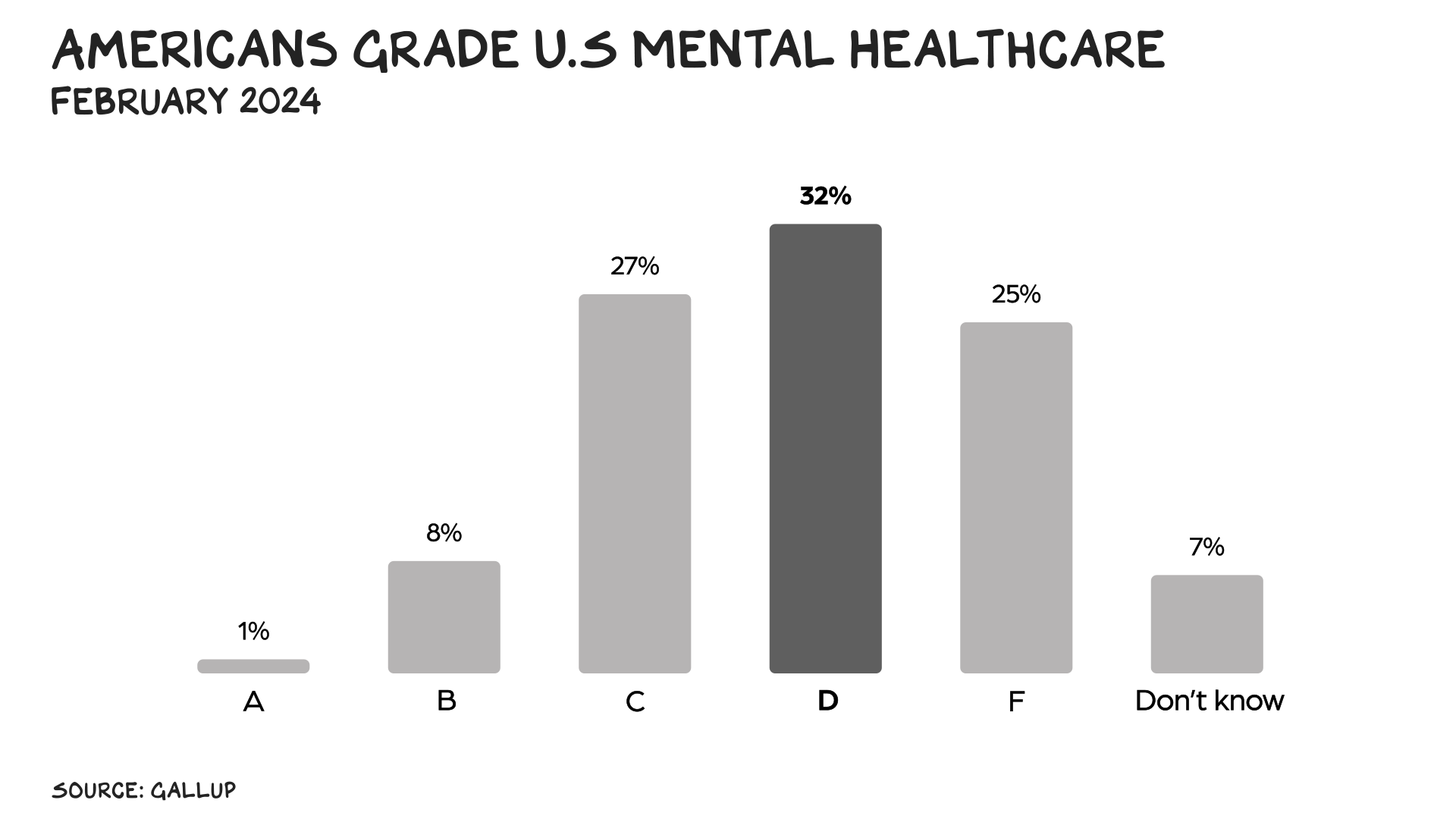
The U.S. has a shortage of mental healthcare providers. But where some see a supply problem, I see a distribution problem. Including psychiatrists, psychologists, licensed clinical social workers, counselors, marriage and family therapists, and advanced practice nurses specializing in mental health care, there are 344 mental health practitioners per 100,000 people in the U.S. We have more mental health practitioners than medical doctors (297 per 100,000) and 5x the number of dentists. According to the U.S. Bureau of Labor Statistics, employment for some mental-health-related occupations is projected to grow by 18% over the next decade — faster than the 3% average for all occupations.
Cost is the No. 1 barrier to accessing mental health services, according to the Kaiser Family Foundation, while getting time off work ranks second. Stigma comes in fourth, behind concerns about efficacy. The two-thirds of Americans who have private insurance likely have access to mental health services, though one-third of therapists don’t accept insurance at all. If you can swing $280 to $400 a month, platforms like BetterHelp are an option. (Note: BetterHelp is a Prof G podcast sponsor.) Meanwhile, Americans living in rural areas likely can’t find a therapist at all. According to one study, counties outside of metropolitan areas had one-third the supply of psychiatrists and half the supply of psychologists as their more urban counterparts. People covered by Medicaid and Medicare struggle to find providers that accept their insurance because of the low reimbursement rates. Finally, underserved groups — people of color, non-English speakers, and LGBTQ communities — often struggle to find appropriate services. But if you’re wealthy, therapy is as easy as reserving a space at SoulCycle. According to the Wall Street Journal, the next big thing in luxury travel is a vacation with a family therapist. The price tag: $80,000.
For everyone else, AI therapy is Sam Altman’s answer. Therapy/companionship was the No. 1 AI use case in 2025, up from No. 2 the previous year. One trial for an AI called Therabot found that it achieved an average 51% reduction in symptoms of depression and a 31% decline in symptoms of anxiety, compared with people who got no treatment. But Celeste Kidd, a psychologist at the University of California at Berkeley who tested another therapy AI called Ash, concluded it was “clumsy” and unresponsive. I’m bullish on AI, but even if it eventually outperforms human therapists, I’m skeptical that Big Tech will provide adequate guardrails. See: Kara Swisher’s interview with the parents of Adam Raine, who died by suicide at 16. They’re suing OpenAI, alleging that ChapGPT was complicit in their son’s death.
No group in America has fallen further, faster than young men. When I began talking about this several years ago, that was a controversial statement, especially on the left, where many pathologize masculinity. While the right has suggested the solution is to take women and non-white people back to the 1950s, the left’s view is that young men don’t have problems, they are the problem. Neither attitude helps. As the left ignores the issue, the right fills the void with misogyny and racism. The result is that a significant number of young men, embracing figures like Andrew Tate and Nick Fuentes, swung right, helping elect a strong man. (If strong equals corrupt and stupid.) To borrow from the vocabulary of therapy-speak, young men don’t feel seen/heard in spaces that are the polar opposite of the manosphere.
Women are twice as likely to receive mental health treatment as men. But is that a failing of masculinity, or the mental health profession, where three-quarters of providers are women? “Guys are built differently,” clinical psychologist John Farrell told Monitor on Psychology. “They have different brains and different ways of being emotional. Male therapists understand male issues differently than females do.” If that sounds sexist, change the pronouns and get back to me.
Therapy has a lot to offer. It also has massive blind spots, especially around class and gender. It’s easy to sling bromides about how everyone needs therapy, but it’s more productive to ask why therapy excludes so many people and too often fails to help the people it does reach. If you’re looking for help on social media, understand this: The platforms and influencers make more money when you stay broken.
Life is so rich,

P.S. This week I spoke with Pulitzer Prize–winning historian Anne Applebaum about what’s really happening inside the Ukraine peace talks. Listen here on Apple or Spotify or watch on YouTube.
The post The Cult of Therapy appeared first on No Mercy / No Malice.
2025-11-21 23:47:57
Today you can “trade” on the outcome of thousands of future events, from the Fed decision next month to the Grammy Awards in February. Without leaving the house, you can wager on Taylor Swift’s wedding or Time magazine’s person of the year. One of Kalshi’s MIT-trained founders says their platform is “like the stock market, but instead of buying and selling companies, you’re buying ‘yes’ or ‘no’ on whether something is going to happen.” The Gen Z billionaire at the helm of Polymarket touts his exchange as a “global truth machine.” These platforms do harness the “wisdom of the crowds,” but, to be clear, this is gambling rebranded as “prediction markets.”
America was built on risk and speculation. The country could fairly be described as a “casino economy,” however, and prediction markets — alongside crypto, options trading, and sports betting — are taking it to new levels.
Weekly volumes for Kalshi and Polymarket breached the $2 billion mark for the first time in October, surpassing the peak reached during the last presidential election. Then came the New York City mayoral election. As residents headed to the polls, they saw billboards flashing the odds: MAMDANI (94%) — CUOMO (6%). With the race over, we can now bet on the likelihood of city buses becoming free before 2027 or rents being frozen. Leveraging its popularity, Polymarket is in talks to raise money at a valuation of $15 billion. Kalshi is attracting offers from VC investors valuing it at $10 billion.
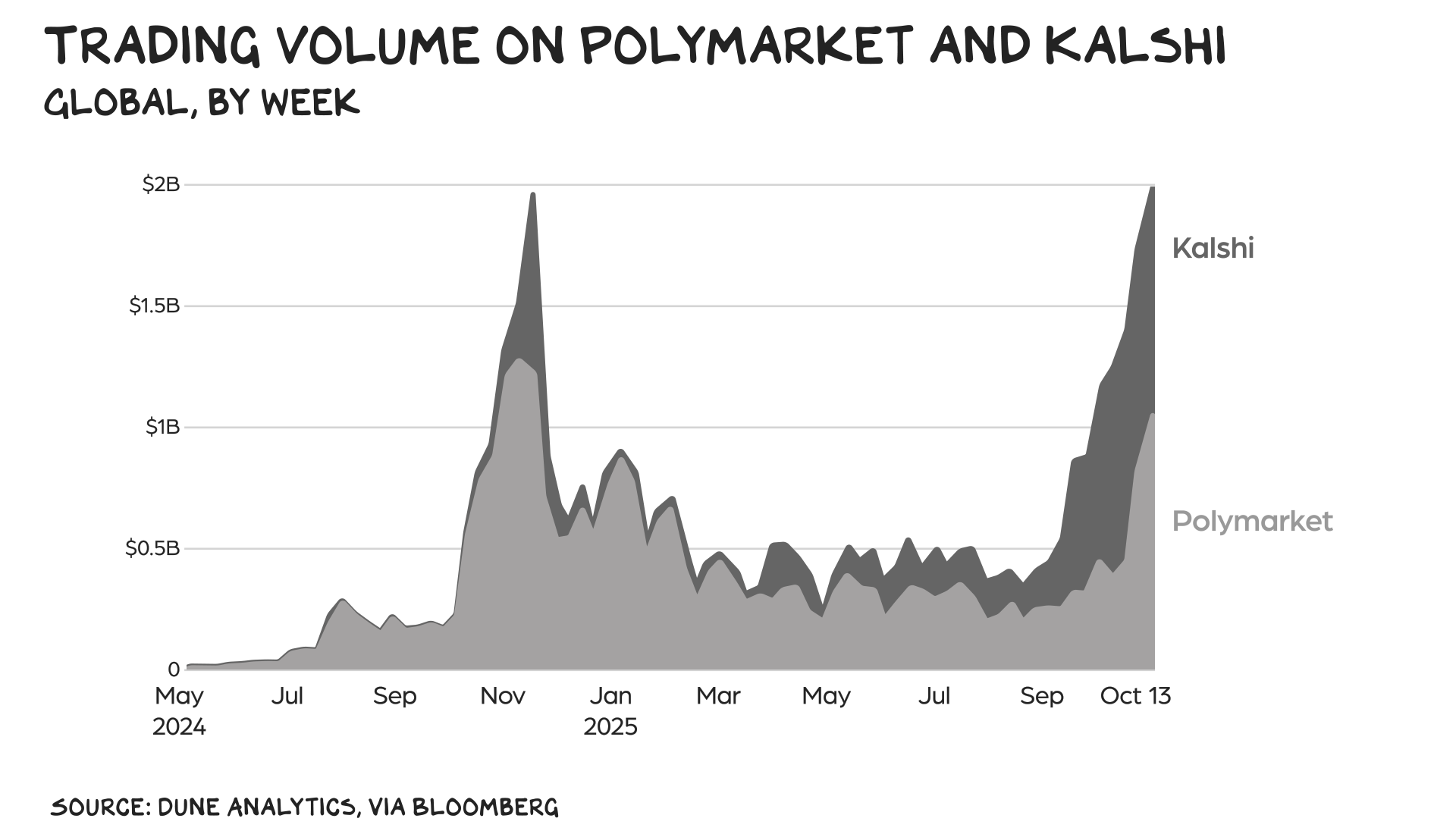
Amid the mania, these platforms are moving deeper into the mainstream:
Sports leagues are also getting in on the action. In October the National Hockey League signed agreements in the U.S. with Polymarket and Kalshi, naming both official partners. Kalshi’s CEO said it’s a clear sign “prediction markets are here to stay.”
Many people seem to have forgotten about Alex Kearns. I haven’t. I remember staring at his photo — a 20-year-old with a big smile and a fascination with the markets — and seeing my oldest son. In 2020, after receiving incorrect messages saying he owed the online trading platform Robinhood $730,000 (he owed nothing), the University of Nebraska student spent much of the night desperately trying to get in touch with the company. The next morning he left a note for his family saying he didn’t want to burden them with this debt. Then he took his own life.
That should have been a wake-up call. Instead, America has doubled down.
The operators have drawn legal challenges from state authorities. The Massachusetts attorney general sued Kalshi, arguing that the company “disguises” sports betting as “event contracts,” which are regulated by the federal Commodity Futures Trading Commission. In states where sports betting is off-limits, customers are turning to prediction markets to “invest” in sports. Sportsbooks mostly restrict access to people under 21. Prediction markets are available to anyone 18 and up.
Don’t count on the Trump administration to intervene. A week before Trump returned to the White House, Kalshi named the president’s eldest son, Donald Trump Jr., as a strategic adviser. Days later, the company publicized its entry into sports betting. Now Trump’s social media company is launching Truth Predict, allowing users to bet on events ranging from elections to inflation-rate changes.
America’s pastime isn’t baseball but gambling.
We spend 10x more on gambling than music, Netflix, and cinema combined. Twenty million Americans struggle with or are at high risk of developing an online gambling problem. Young men are especially vulnerable. Men are more susceptible to gambling than women, just as they’re more likely to engage in illicit drug use, drink excessively, or die of opioid-related overdoses. Gambling has the highest suicide rate of all addictions. When you have a meth addiction, people notice — the sores, tooth loss. When you’re gambling, and you’re in deep, you lose your kids’ college fund or mortgage the house, but your struggles remain hidden.
The Supreme Court’s decision in 2018 to overturn a federal ban on sports betting has fueled the nation’s compulsion. Before the ruling, Americans legally wagered less than $5 billion on sports annually. Last year, with sports gambling legal in more than three dozen states and D.C., those bets ballooned to $160 billion. The mediums shapeshift to distract, but they are gambling. Some of the costumes:
We know what happens when you give states the green light: Bankruptcies soar 30%. Americans grasp the scale of the crisis. More than 40% of adults see legalized sports betting as a “bad thing for society.” Still, the dopamine cocktail is too much to resist.
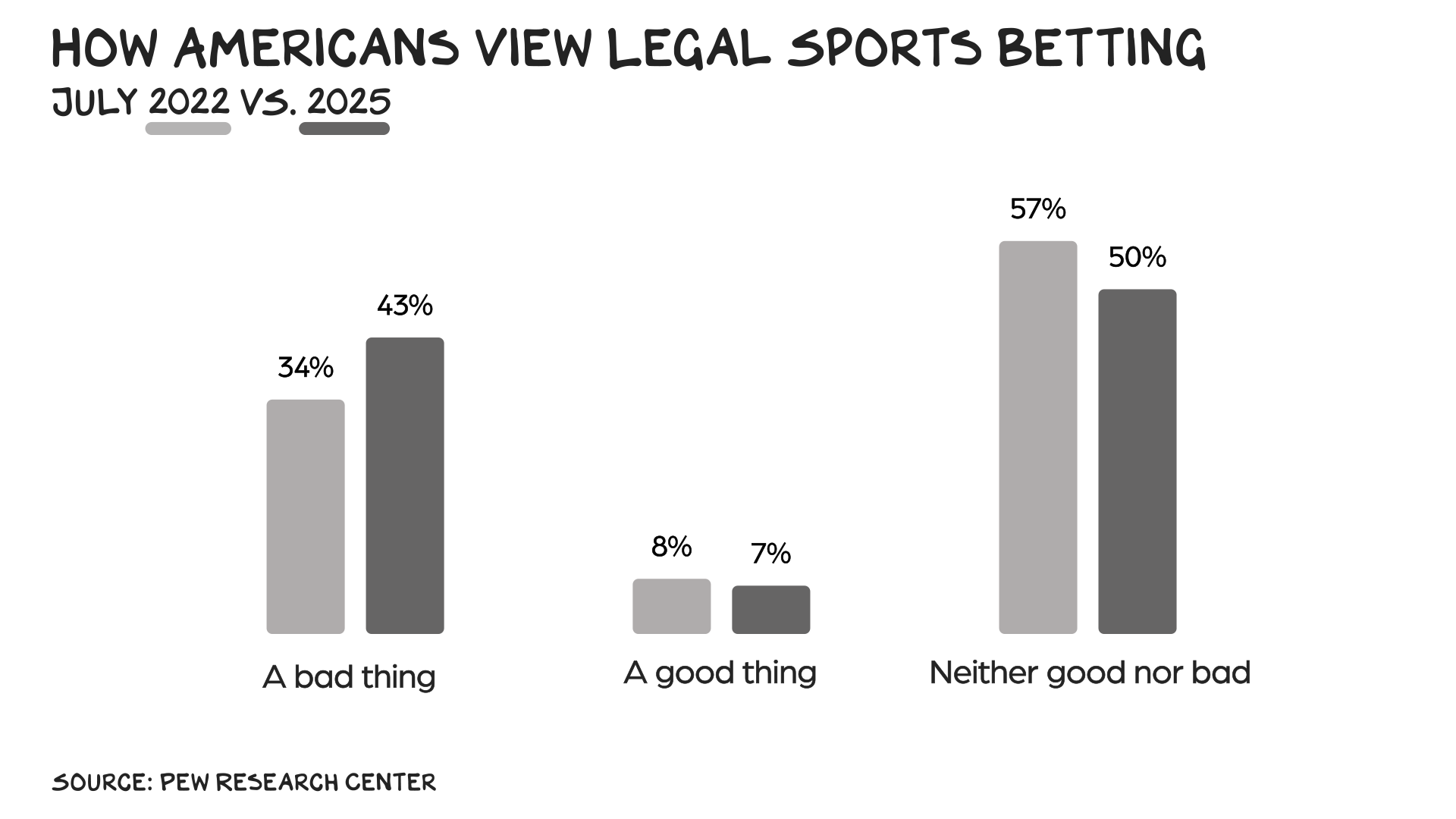
Sports leagues aren’t going to lose their zeal for gambling, despite back-to-back betting scandals in the NBA and MLB that raised concerns about the integrity of the games. Spoiler alert: The leagues will distance themselves from the alleged conspirators — but not from the gambling industry. Direct sponsorship deals between legal sportsbooks and top leagues may be worth more than $1 billion annually. A number of teams have agreed to put physical betting shops inside their stadiums and arenas.
For a moment, it appeared the NFL was concerned. In June the league announced a partnership with the International Center for Responsible Gaming to support research into gambling among college athletes and students. But this is a league that aligned with Caesars, FanDuel, and DraftKings and hosted its first Superbowl in Vegas last year. Just as we’ve made a conscious decision to transfer wealth from young to old and poor to rich, we’ve accepted a system in which money flows from fans to leagues.
There are solutions, if we have the courage to implement them. We could do more to educate consumers about the dangers and impose tougher regulations, including age restrictions. Limiting annual losses, restricting advertising, and setting up firewalls between research into gambling’s impact and the industry itself are all on the table. Paul Tonko and Richard Blumenthal, Democratic lawmakers, have proposed measures that would be a good start. However, it’s an uphill battle. The most profitable firms in history are squatting in a building (our economy) that has no scaffolding on its instincts … any sort of dopa regulation trails institutional production.
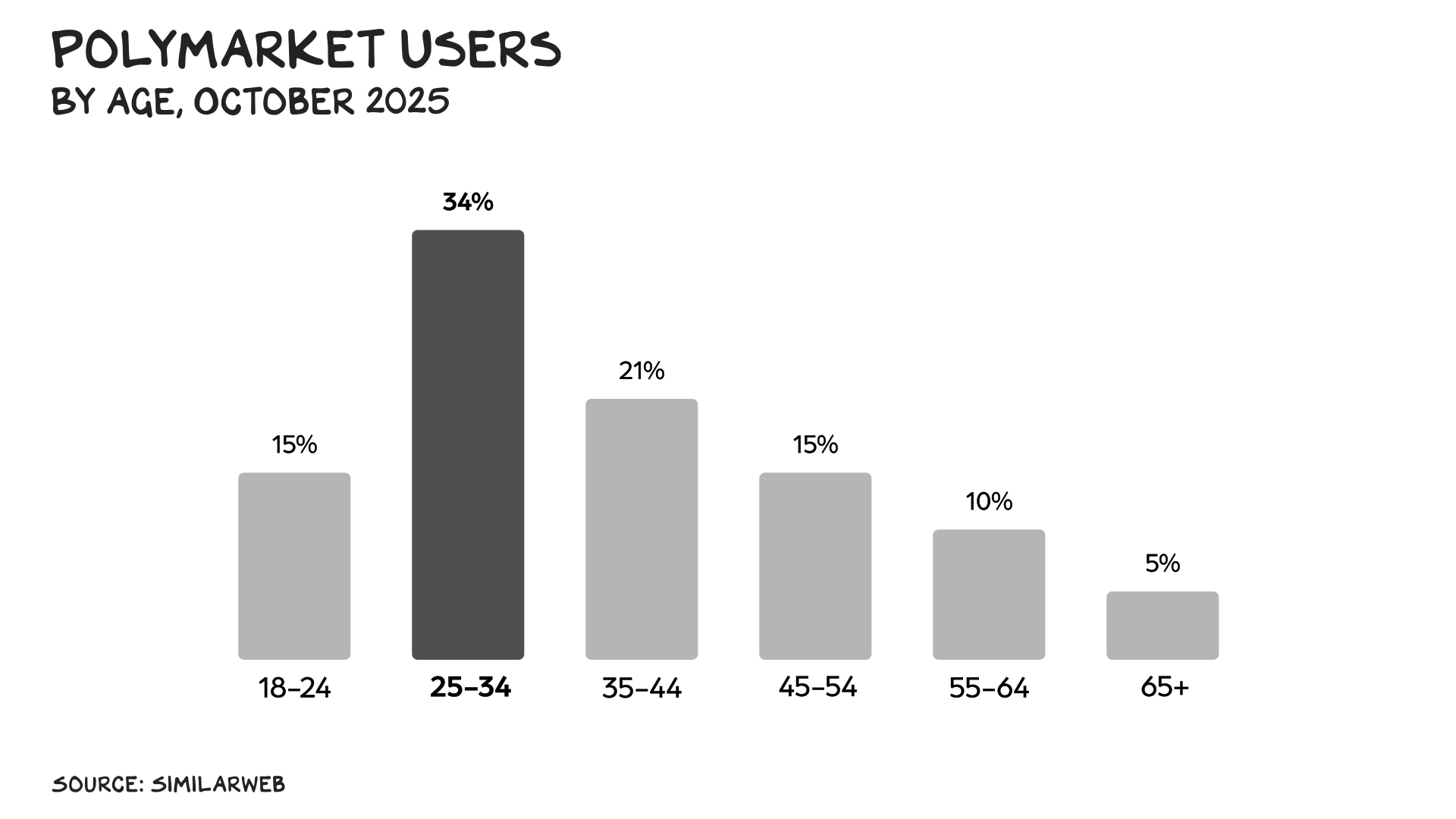
Prediction marketplaces say they aren’t on the other side of the trade — users are trading with their peers, not against the “house.” As traders buy and sell, prices fluctuate to reflect the “collective sentiment and knowledge of market participants.”
But whether you’re putting money on the Mets or Mamdani, this is gambling, and whatever you want to call it, users can develop an addiction. I am not immune. I find these markets fascinating — I tried to bet on the presidential race but couldn’t, as I’m an American citizen living in the U.K. My documented worker status saved me from myself: I was convinced Kamala Harris had a greater-than-37% likelihood of capturing the White House. And there is a solid argument we shouldn’t infantilize grown-ups — and we should let them spend their hard-earned money as they see fit.
In the U.S. we’ve monetized healthcare, the White House, and the pardon process. However, these are dwarfed by the opportunity to monetize the less developed prefrontal cortex of a young man. Once Polymarket starts expanding in the U.S., more Americans will be swept up by the wave. Not because everyone will be in Vegas, but because Vegas will be in everyone. If policymakers aren’t motivated by the threat to Americans’ finances and mental health, they should worry about the risk of foreign governments using the platforms to influence elections and public perception.
The most profitable companies all do the same thing: They tap into our flaws and monetize them, then pretend it’s innovation rather than exploitation. We need to have a wider debate about the society we want. Rather than celebrating gambling, we should embrace a different kind of risk: asking someone out, approaching a stranger, investing in relationships with friends and potential mates. This is what I ask myself when I mentor young men: How can I increase their risk appetite for the real world? How do we create a societal movement to convince people to bet on each other, not platforms? Will there be thoughtful regulation?
I don’t know, but I’m certain we’ll be able to bet on it.
Life is so rich,

P.S. I’ll reveal my Predictions for 2026 on December 4th at a free live event hosted by Section. Sign up here.
The post The Next Opioid Crisis appeared first on No Mercy / No Malice.
2025-11-15 01:03:35
An Office Hours listener asked what I’d say to President Trump if he invited me to the White House. I’ve struggled my whole life with being right vs. being effective. So, as we’re meeting with the president … let’s focus on being effective. We don’t have much common ground, but we’re both fathers. Let’s start there. As we’d likely have only a few minutes, we’d need to be focused — one issue max. The one thing I’d advocate for? I’d make a case for mandatory national service, as I believe that even the most polarized societies can find common ground when it comes to their children. (Yeah, I know, the whole denying SNAP benefits to kids. But it’s my imaginary meeting, so just go with it.)
I believe young Americans are fed up with a country they’re raised to love but that doesn’t love them back. Our spending priorities (entitlements), tax policies (capital gains and mortgage interest deductions), and fiscal priorities (bail-outs of incumbents) are the greatest transfer of wealth from young to old in history. Old people have figured out a way to vote themselves more money, and even if the younger generations aren’t good at it, they can do math.
The unemployment rate among 16- to 24-year-olds is 10.5% — the highest since the pandemic and, excluding that period, the highest since 2016. Zoomers report feeling more lonely, depressed, and anxious, and less successful, than other generations. It doesn’t help that 200-plus times a day they receive notifications on their phone that they’re failing, as their cohort vomits fake wealth/success onto them. The most noxious emission in America isn’t carbon but shame. Young people aren’t facing one crisis but a cascade of them — and that’s made worse by adults who enjoyed the shade of trees planted by others but are now clear-cutting forests meant for the next generation.
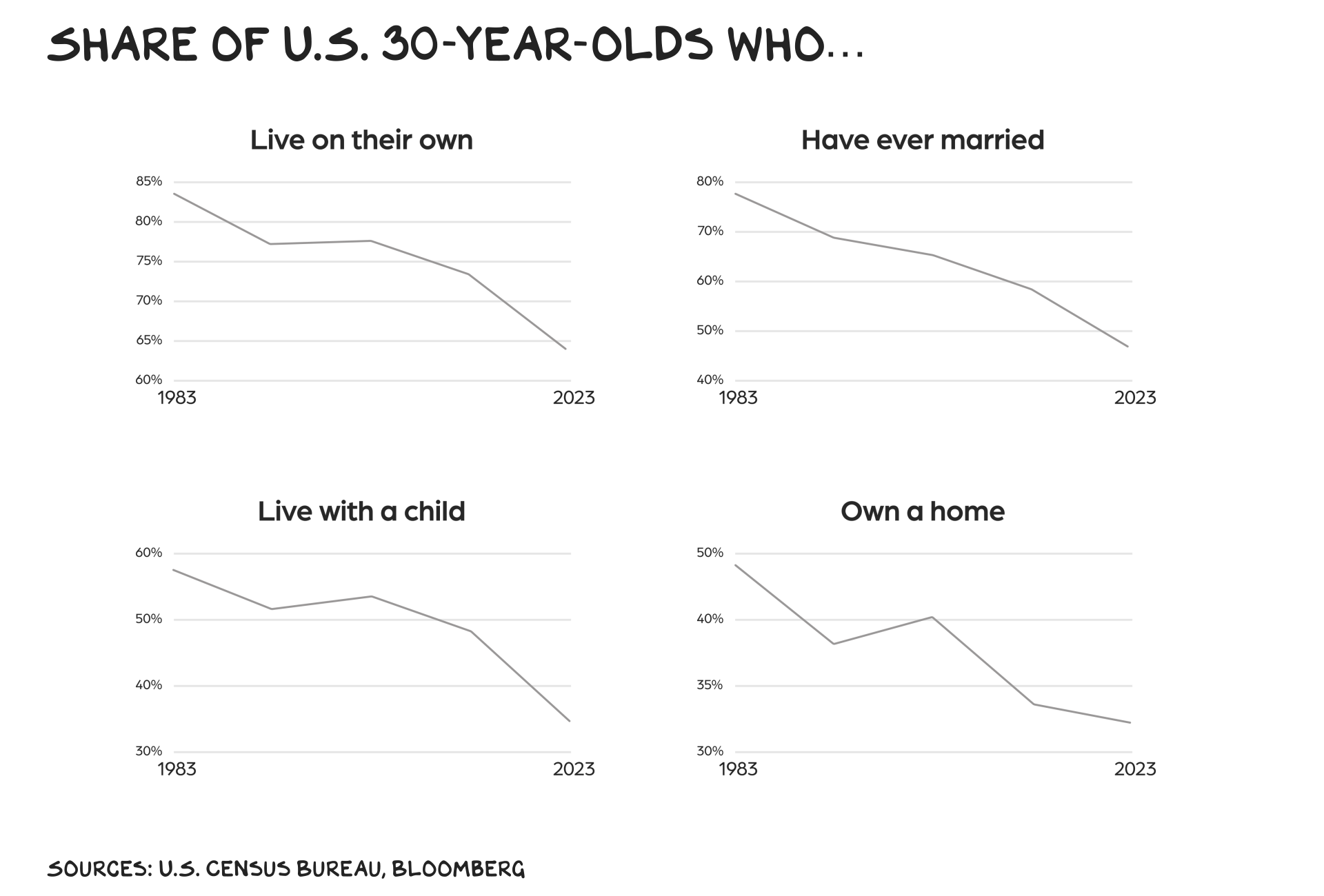
My parents belonged to the Greatest Generation. Their collective sacrifice won World War II, while their sense of national identity, forged by service, fueled the prosperity and progress of post-war America. On Prof G Conversations, historian Heather Cox Richardson told me “there was a very different sense of what it meant to be an American” then, adding that people prided themselves not on how much money they made, but how they took care of their communities. Writing about the people who came of age in post-war America, journalist Tom Wolfe coined the term the Me Generation. Prosperity created what Wolfe called “the luxury of the self.” I know that luxury well. I didn’t serve my country — one of my great regrets. Marketplace host Kai Ryssdal, a contemporary and Navy veteran, told me national service would transform America. “We don’t know each other anymore,” he said. “It’s a generational thing.”
At the end of Notes on Being a Man, I close with a letter to my sons, urging them to be patriots — to vote, pay taxes, and be evangelists for America and its values. I encourage them to give others the benefit of the doubt and treat them with respect, if only because they’re fellow Americans. For my boys’ generation, their fellow citizens are strangers. Our connective tissue is fraying. According to Gallup, the youngest Americans are the least patriotic. I believe mandatory national service could help repair the damage by encouraging young people to see themselves as Americans, first and foremost, and to be proud of that identity.
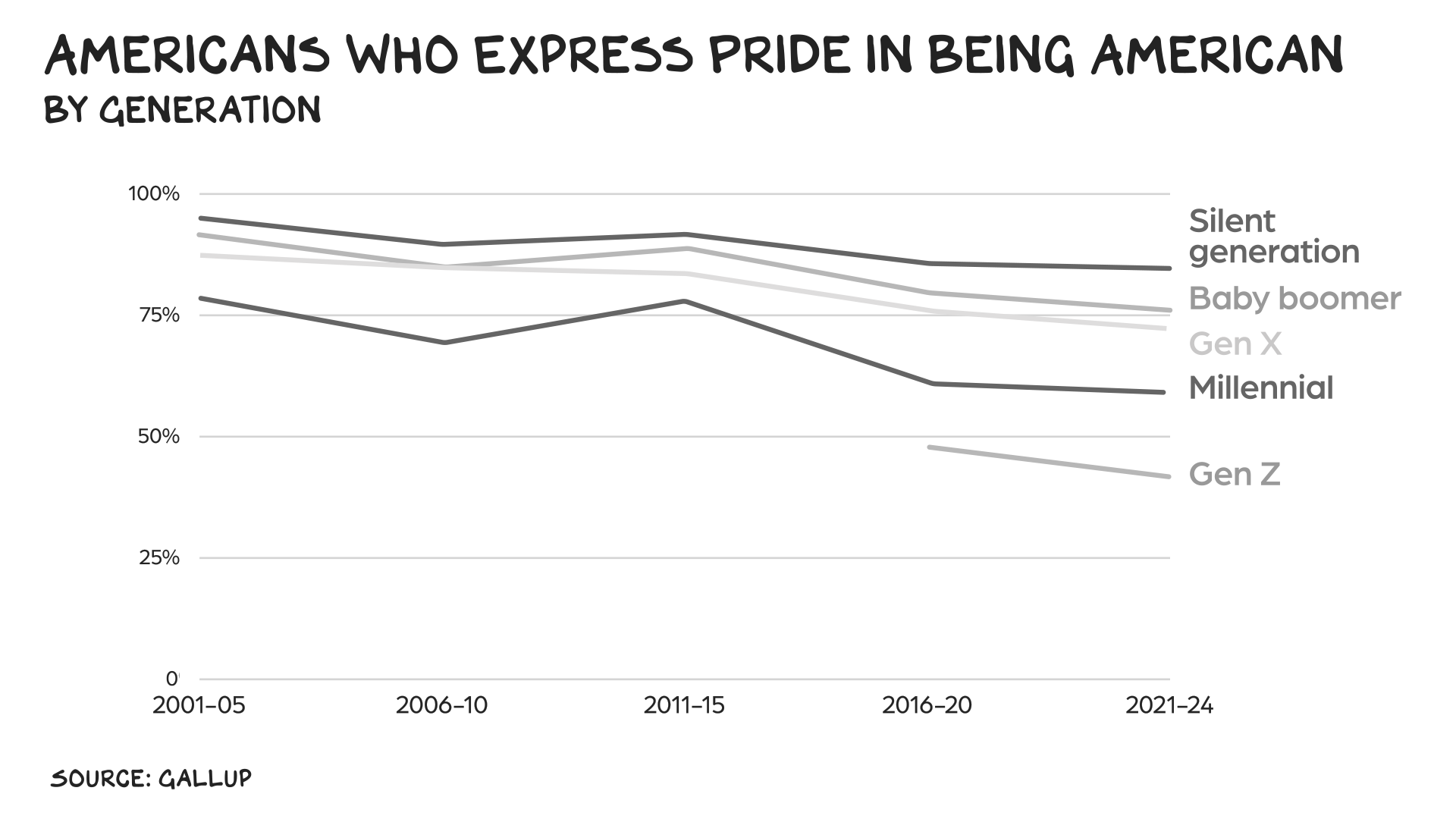
National service in Singapore, the most religiously diverse nation on Earth, is called “school for the nation,” because of its ability to forge a national identity. A study that looked at Singapore’s national service programs concluded that socialization is a key mechanism for transmitting norms and values, while contact with people from different groups reduces prejudice. Those who serve in units that are housed together were 17% less likely to close ranks around their demographic group. By comparison, each year of education beyond secondary school achieves the same effect, but by only 2.5%.
In the U.S., 6% of adults are veterans, while active-duty service members comprise less than 1% of all adults. An estimated 64,000 young Americans and an additional 200,000 seniors volunteer for AmeriCorps, the primary umbrella organization for civilian service programs. We have the programs, but lack scale. Still, we know what works. Democratic Congressman Jason Crow, an Army veteran, favors expanding voluntary national service. On Raging Moderates he said, “When city kids get together with farm kids, and white, Black, Asian, Latino, straight, and gay people roll up their sleeves and build something together … that creates a foxhole mentality that breaks down barriers and connects us.” The sentiment is bipartisan. Republican Senator Bill Cassidy has co-sponsored bills to strengthen AmeriCorps and provide tax relief to volunteers. Republican Senator Todd Young co-sponsored the Unity through Service Act. In 2016 candidate Trump said there was “something beautiful” about national service. On that point, we agree.
Enlisting in the military isn’t the only way to serve. The U.S. has a long history of civilian national service programs. While the mission of each program varies, Congress has historically identified two goals for national service: meeting the needs of communities and developing the capacities and character of participants. Underinvestment in these programs is an American tragedy. As a 2018 NIH report put it, “Higher levels of civic responsibility, voting, volunteering, employment, respect for diversity, and overall life skills such as decision making and time management are all associated with AmeriCorps participation.” We should ramp up AmeriCorps and define service broadly, as our nation’s needs are as diverse as our people. How young people serve — being rural firefighters, volunteering in a no-kill animal shelter, helping seniors, working in our national parks, — isn’t nearly as important as the service itself.
Budgets illuminate national priorities and values. Our three largest expenditures — Social Security, Medicare, and the interest on the debt — are nearly half of the federal budget, mostly benefiting the 18% of Americans who are over 65. The Department of Education and SNAP — spending that overwhelmingly benefits the 30% of Americans under 25 — register 4% and 1.5% of the budget, respectively. To paraphrase Warren Buffet, there’s a generational war in America, and my generation is winning. The D in Democracy only works when wealthy (i.e., old) Americans elect even older Americans who then vote themselves more money.
What if instead of using “the future” and “children” for rhetorical flourish, we actually walked the walk and invested in them? A Brookings report estimated that if we expanded existing national service programs to include 600,000 young people, it would cost $19 billion per year; Americans spent 8x that amount on their pets last year. Scaling up to include all 3.9 million members of the high school class of 2025 would increase the cost to $123 billion. That’s real money, but it’s only about 17% of our nearly $700 billion annual tax gap — the difference between taxes owed and taxes collected. Expanding service opportunities would also generate an estimated 17x return on our investment, according to a 2020 analysis of AmeriCorps programs.
The benefits would be felt across society, as participants would augment nonprofits, as well as state and local government initiatives. Federal and local governments would also benefit from programs that address community challenges early, lessening dependence on other government programs and reducing expenditures in criminal justice, welfare, and public health. Meanwhile, people who complete a national service program would enter college or the workforce with more skills and greater confidence.
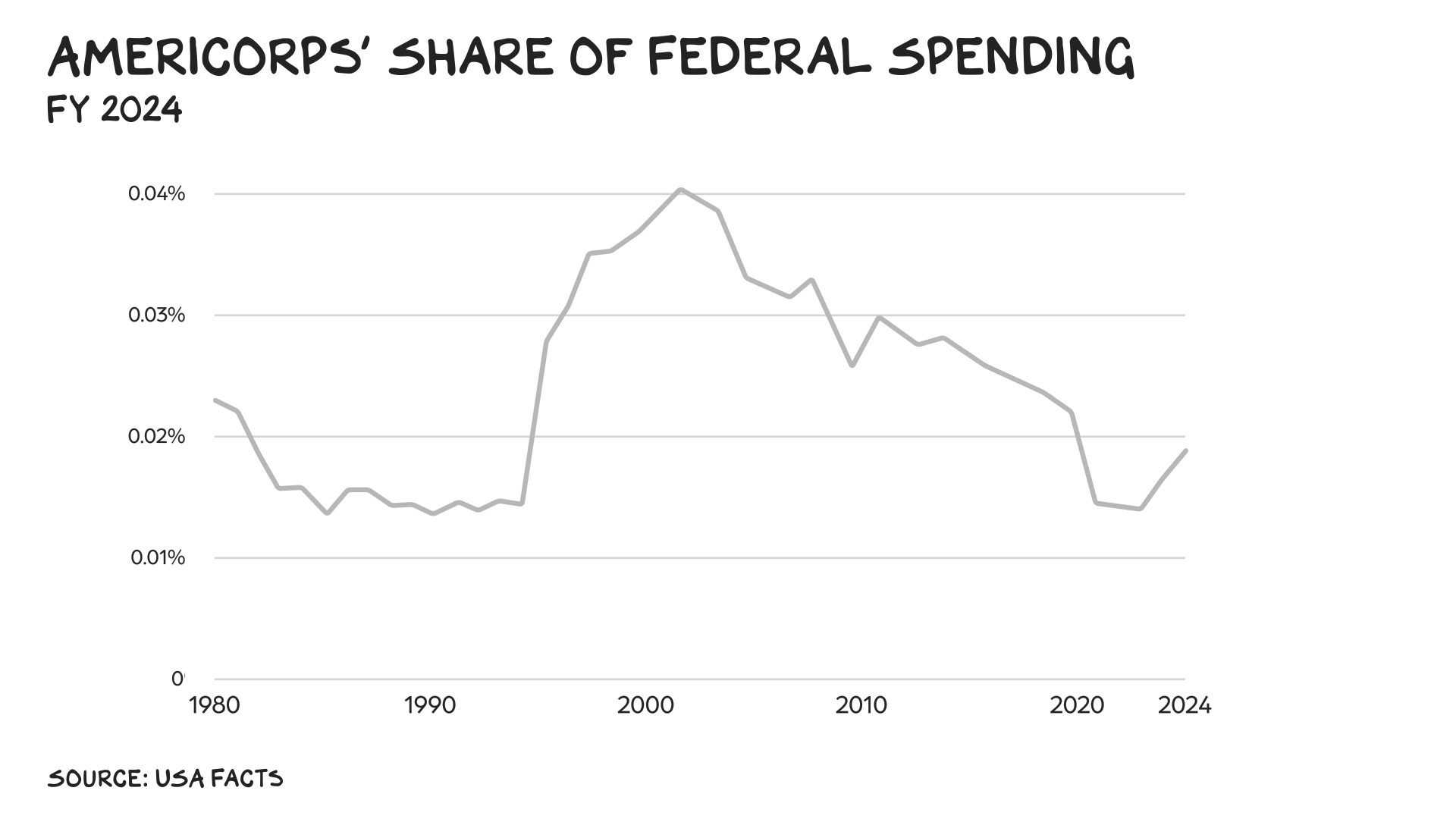
National service benefits everyone who serves, but the benefits are likely more profound for boys — a cohort that’s fallen farther and faster than any other group in recent memory. For boys, physical development progresses more rapidly than intellectual or emotional maturity. My friend Richard Reeves has argued in favor of “red-shirting” boys, just as we hold back college athletes for a year so they can develop further on the field. A structured period of one or two years after high school would give boys the opportunity to mature without the pressures of college or a career. It would also give some a second chance. Former IDF boss General Aviv Kochavi called national service a “societal take two” for young Israelis. “It doesn’t matter where you came from or what your background is,” he wrote. “A mediocre pupil or youth with a criminal past who dropped out of school can leave the past behind and become an outstanding leader.” We should give the same opportunity to every young person in America.
If we want our youth to feel invested in their country, then America needs to invest in its youth.
Life is so rich,

P.S. In our newest Prof G Podcast, China Decode co-hosts Alice Han and James Kynge unpack how the U.S. and China are building massive data centers that are reshaping global energy use and government policy. Listen here on Spotify or Apple or watch on YouTube.
The post National Service appeared first on No Mercy / No Malice.
2025-11-07 23:24:16
Donald Trump pulled off a stunning political comeback because of … young men. While the Democrats ignored this demographic, the far right rushed in to fill the void, flooding the manosphere with rockets, Hulk Hogan, coarseness, and crypto. The last presidential election was supposed to be a referendum on women’s rights. It wasn’t. It was a referendum on struggling young men.
Five years ago my advocacy for young men sparked a hostile response. Today society is ready to have a productive dialogue, rejecting the far right’s attempts to send non-white people and all women back to the 1950s and the left’s belief that young men don’t have problems but are the problem. This isn’t a zero-sum game. We can build on the gains women have registered over the past three decades and ensure there’s room for boys and young men in the conversation. Democrats are starting to tackle the crisis, but we can’t rely on prominent party leaders to drive the change. We can count on the tech industry, however, to keep supporting their massive valuations by connecting profits with the sequestration and enragement of young men. Men ages 20 to 30 now spend less time outside than prison inmates.
Men of my generation have a debt to these young men. Our unfair advantage must be paid forward (or backward). We need to get involved in their lives, advocate for policies to right the ship, and model a healthier vision of masculinity. All of us have a role to play in giving young men a code — a positive set of principles — to live by.
Below is an excerpt from my new book, Notes on Being a Man. This one is personal. I hope it resonates with you.
________________
One of the semi-exciting perks of being an academic and “thought leader” is uncovering data, especially when it’s both obvious and hidden. Years ago, the alarming state of American boys and men overtook my attention. I track closely the emails I get. Most are from parents, particularly mothers, concerned about their sons, along these lines: “I have a daughter who lives in Chicago and works in PR and another daughter who’s at Penn.
My son lives in our basement, vapes, and plays video games.” Moms, not dads, were leading the charge. Others were either ignoring the problem or didn’t want to talk about it. Absent, too, was any sober, data-driven analysis. The gag-reflex cultural response seemed to be Wow, men are worse than we think, and that the issues they face are a function of their awfulness, and haven’t we spent the past forty years correctly focused on the struggles of other, more deserving groups?
I connected to this topic on a personal level. I thought back on where I came from, my mom’s irrational passion for my well-being, the generosity of California taxpayers who made it possible for an unremarkable kid with mediocre grades to attend college and business school, and all the obstacles, temptations, and traps that could have easily hampered my socialization — smartphones, online dating, porn, gambling, video games, remote work. I wondered why what was happening to boys and young men was in fact happening and how I could raise my sons in a world where they — and males of any age — thrive.
The data around boys and young men is overwhelming. Seldom in recent memory has there been a cohort that’s fallen farther, faster. Why? First, boys face an educational system biased against them — with brains that mature later than girls’, they almost immediately fall behind their female classmates. Many grow up without male role models, including teachers — fewer men teach K–12 than there are women working in STEM fields — with Black and Hispanic school instructors especially underrepresented.
Post–high school, the social contract that binds America — work hard, play by the rules, and you’ll be better off than your parents were — has been severed. Seventy-year-old Americans today are, on average, 72% wealthier than they were forty years ago.
People under the age of forty are 24% less wealthy. The deliberate transfer of wealth from the young to the old in the United States over the past century has led to unaffordable and indefensible costs for education and housing and skyrocketing student debt, all of which directly affect young men. It’s why twenty-five-year-olds today make less than their parents and grandparents did at the same age, while carrying debt loads unimaginable to earlier generations. Neither the minimum nor the median wage has kept pace with inflation or productivity gains, while housing costs have outpaced both. As the costs of college have soared beyond the reach of most families, many of the manufacturing jobs that didn’t require a college degree and were often a ticket to the middle class for (mostly) men have been offshored. A prohibitive real estate market is a contributing factor to why 60% of young men between the ages of eighteen and twenty-four live with their parents and 1 in 5 still live with their parents at age thirty. Stuck and unable to afford greater economic opportunities in nearby cities, they find the same crush and collision of density, stimulation, humanity, creativity, eroticism, and conversation that urban areas offer on their phones instead. In Manhattan, a four-hundred-square-foot apartment costs $3,000 a month. In its stead is a seventeen-square-inch mobile studio apartment costing roughly $42 a month, served up by AT&T, T- Mobile, or Verizon.
Meanwhile, algorithmically generated content on social media contributes to—and profits from—young men’s growing social isolation, boredom, and ignorance. With the deepest-pocketed firms on the planet trying to convince young men they can have a reasonable facsimile of life on a screen, many grow up without acquiring the skills to build social capital or create wealth. The percentage of young men aged twenty to twenty-four who are neither in school nor working has tripled since 1980. Workforce participation among men has fallen below 90%, caused by a lack of well-paying jobs, wage stagnation, disabilities, a mismatch of skills and/or training, and falling demand for jobs traditionally held by prime-age men.
This is deadly. From 2005 to 2019, roughly 70,000 Americans died every year from deaths of despair — suicide, drug overdoses, alcohol poisoning — with a disproportionate number of those fatalities being unemployed white males without a college degree. Excluding deaths caused by the opioid epidemic, America’s suicide and alcohol-related mortality rate for all races is higher than it’s been in a century. It’s also a mating crisis, as women traditionally mate horizontally and up socioeconomically, whereas men mate horizontally and down. Up until the mid–twentieth century, homogamy — marriages between men and women from similar educational backgrounds — was more common than not. Today, hypogamy, where women marry men who have less education than themselves, is on the rise. When the pool of horizontal-and-up young men shrinks, there are fewer mating opportunities, less family and household formation, and not as many babies. Here’s a terrifying stat: 45% of men ages eighteen to twenty-five have never approached a woman in person. And without the guardrails of a relationship, young men behave as if they have … no guardrails.
Why are we so averse to identifying and celebrating what’s good about men and masculinity, and why does it matter? Because we won’t prosper if we convince boys and young men that they’re victims, or that they don’t have to be persistent and resilient, or that their perspective isn’t valuable. If we do, we’ll end up with a society of old people and zero economic growth. If we can’t convince young men of the honor involved and the unique contributions inherent in expressing what makes them male, we’ll lose them to niche, rabid online communities.
As my Pivot podcast cohost Kara Swisher commented once, it should matter to everyone if men aren’t thriving. Women and children can’t flourish if men aren’t doing well. Neither will our country.
Life is so rich,

P.S. Notes on Being a Man was published this week and is available in all the usual places.
The post Notes on Being a Man appeared first on No Mercy / No Malice.